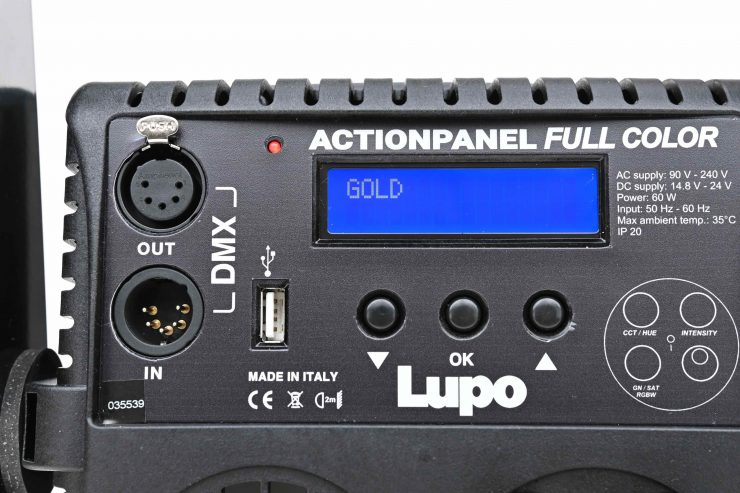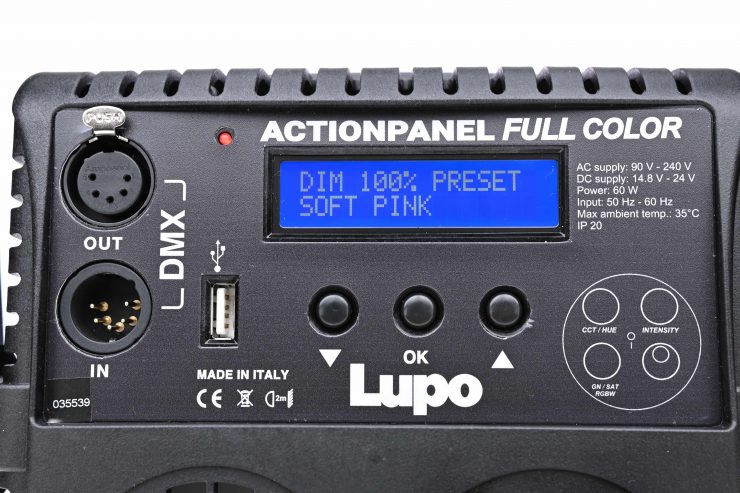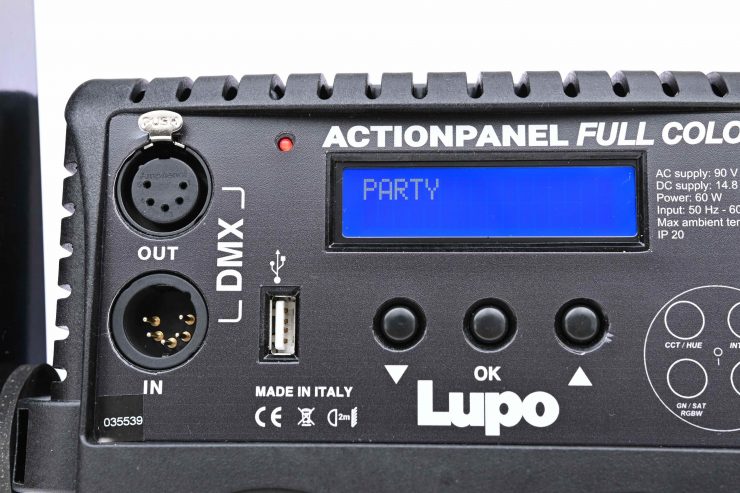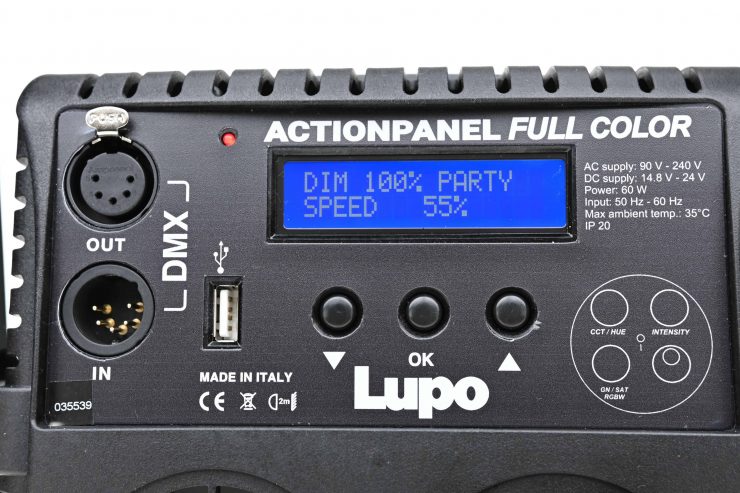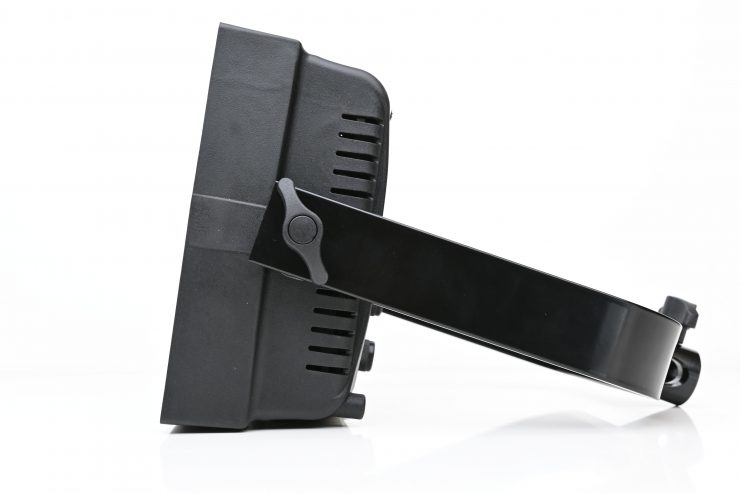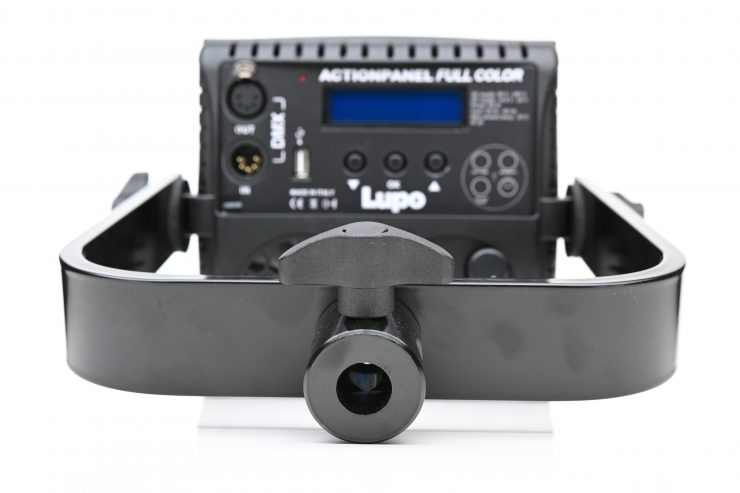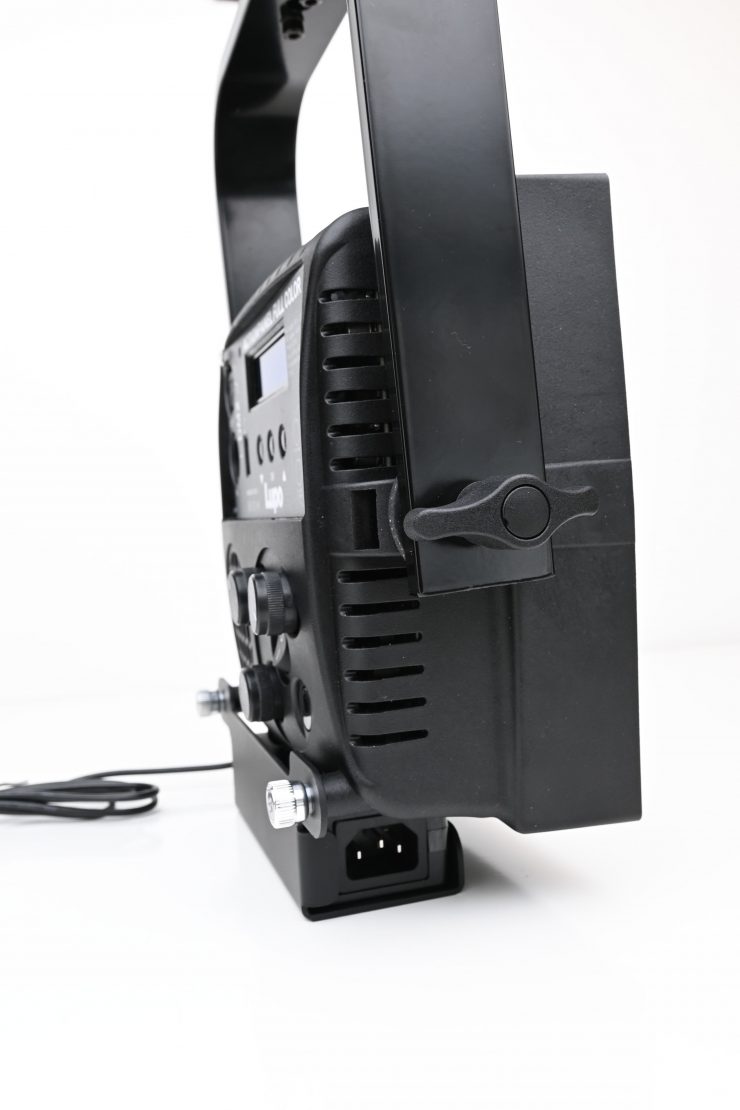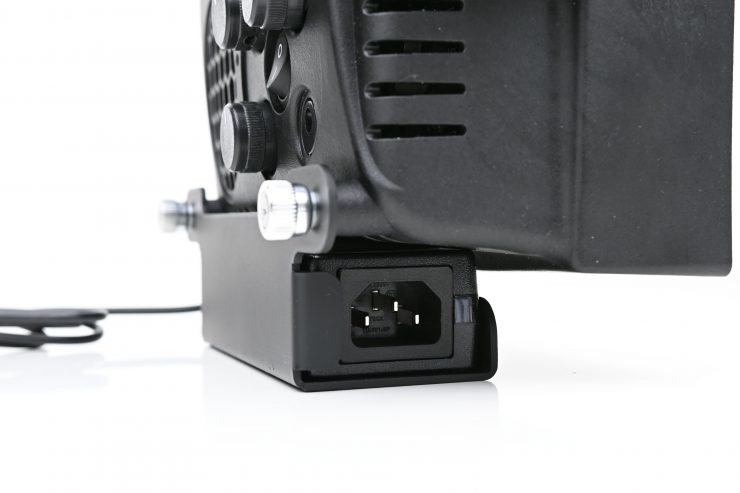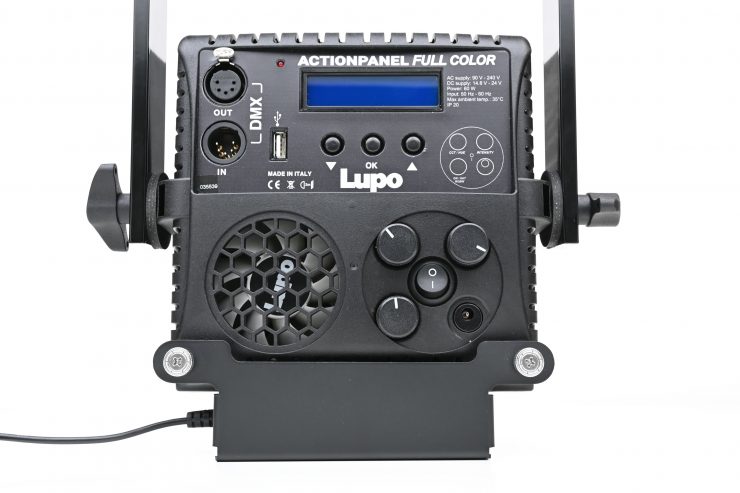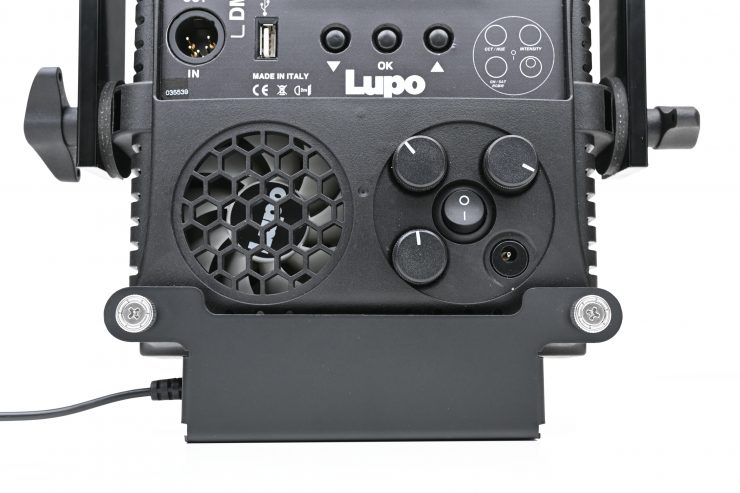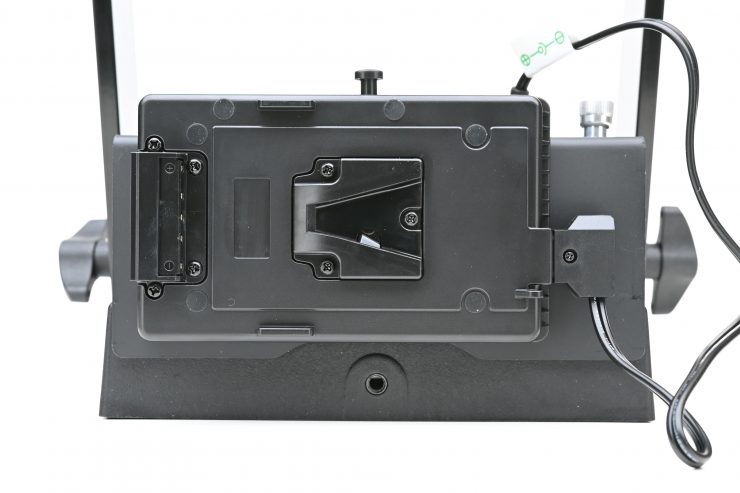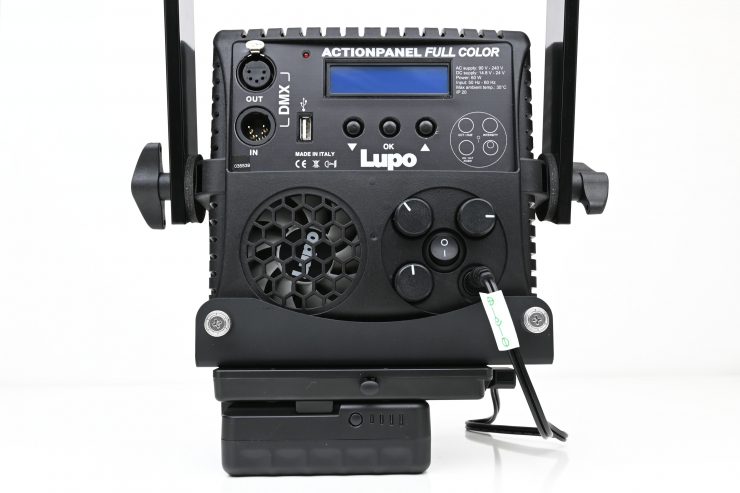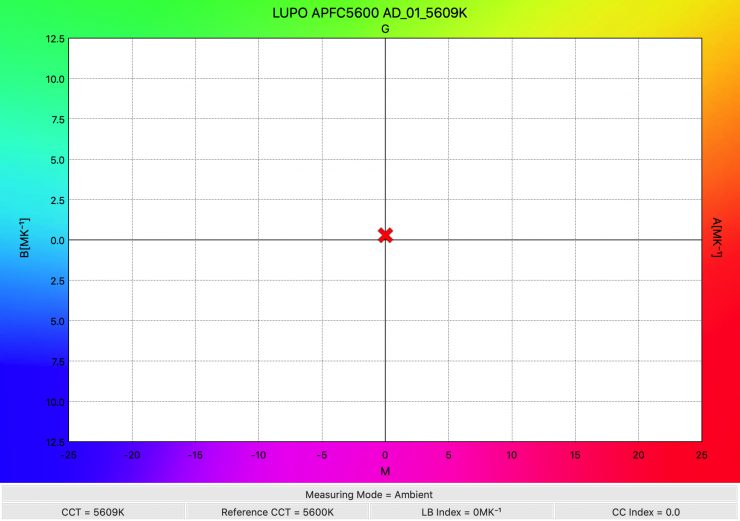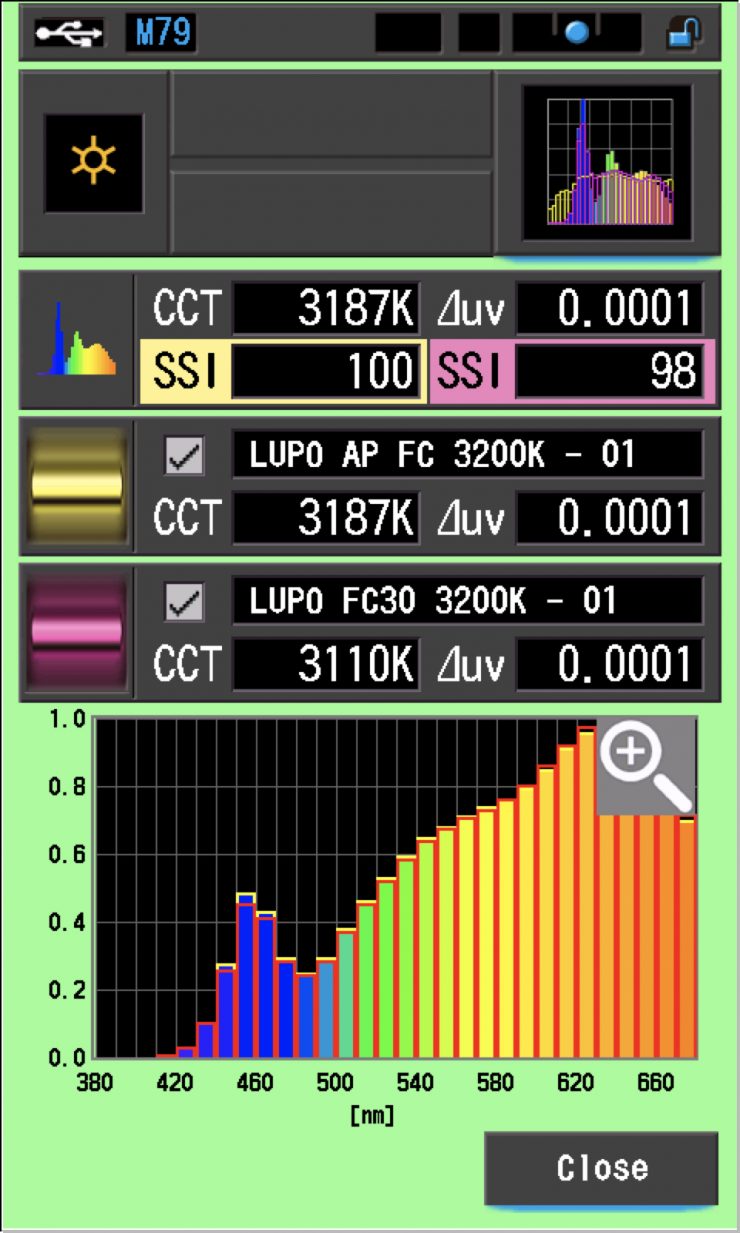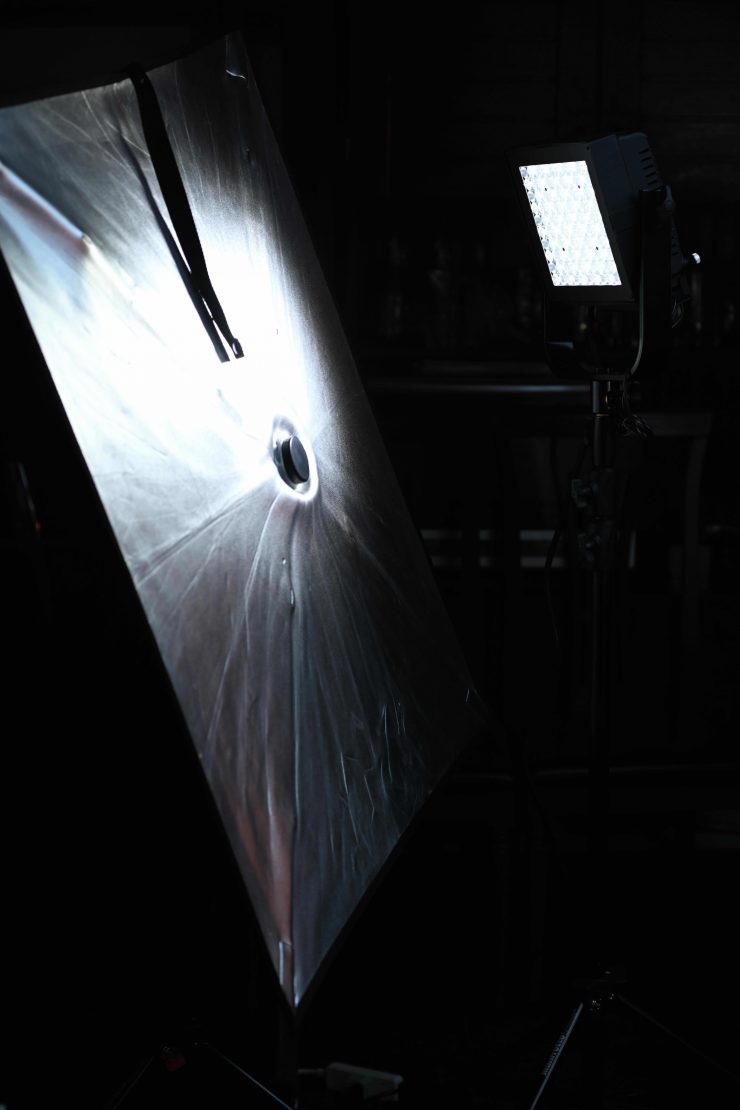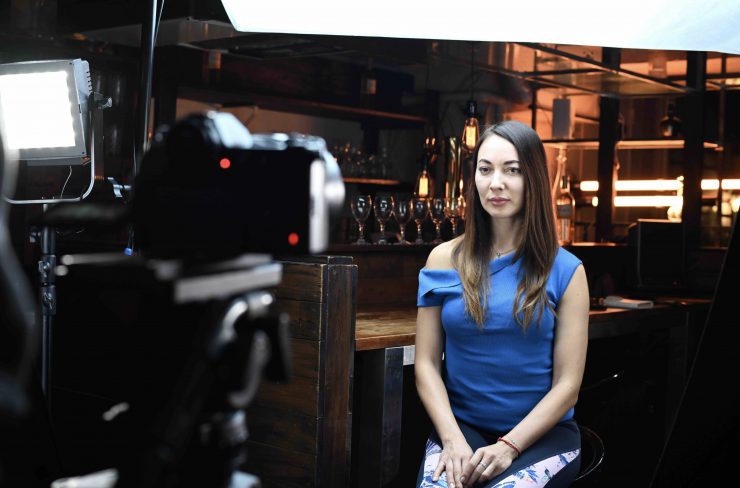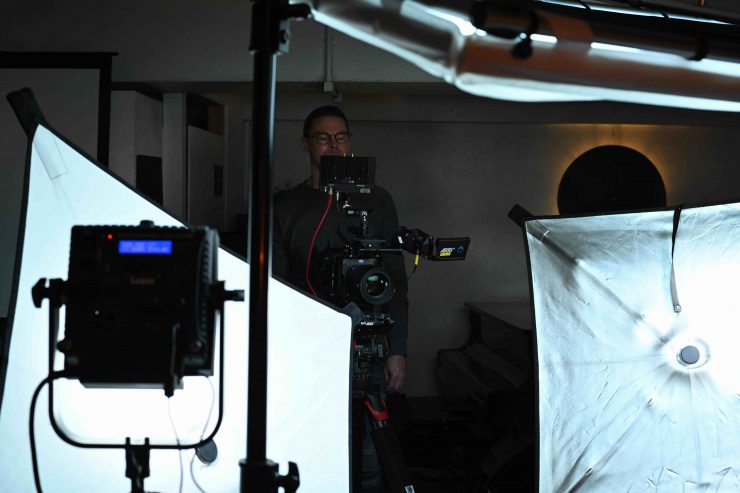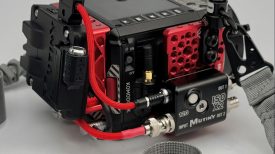
The Lupo Actionpanel is a new range of powerful, compact, and easy to use portable lights.
We first saw the lights presented at IBC 2109. Above you can see our video interview with Lupo at the show.
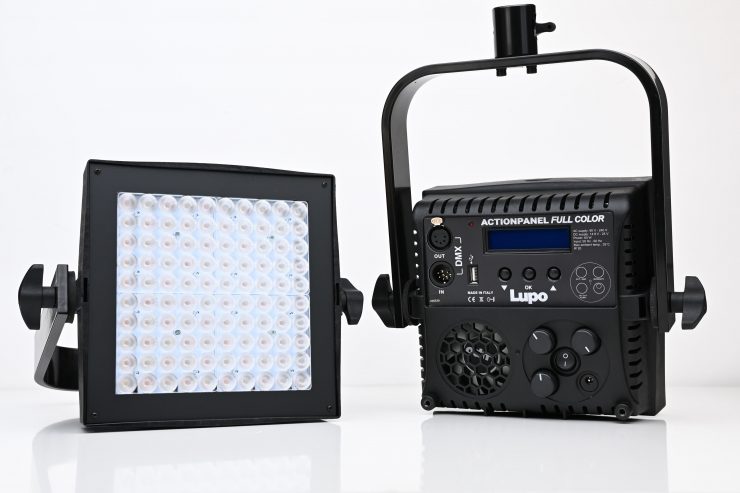
The Lupo Actionpanel currently comes in two versions. A Dual Color and a Full Color.
Lupo has garnered a good reputation for making high quality, affordably priced LED lights that have a very high output.
I have previously reviewed quite a few of their lights on the site, and they have almost always exceeded expectations.
A Mini Superpanel?
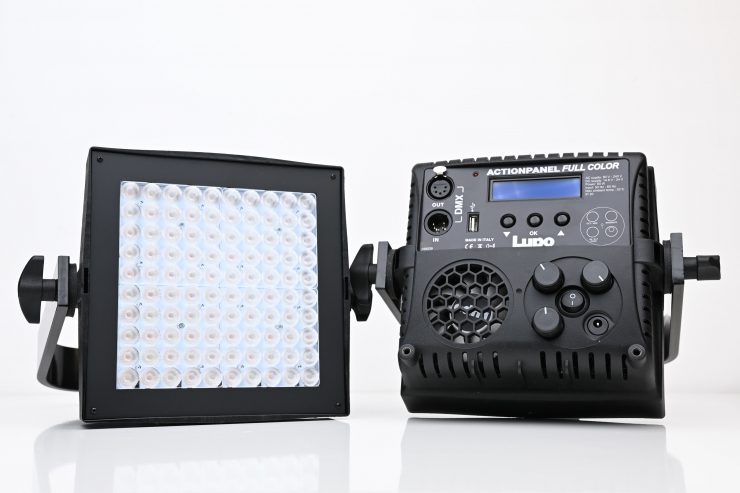
Up until now, Lupo has mainly made larger sized fresnel and 1×1 and 2×1 fixtures. The Actionpanel, at least in my perspective, should be viewed as a Mini Superpanel.
With more and more shooters using smaller cameras and trying to keep the weight and size of all of their equipment to a minimum, there is a real need for powerful, smaller sized lights.
What I like about the Superpanel is that it strikes a nice balance between a larger 1×1 and a smaller sized on-camera light. There really aren’t than many lights out there that that fit into this category.
So let’s have a look at the two models that are available.
Actionpanel Dual Color
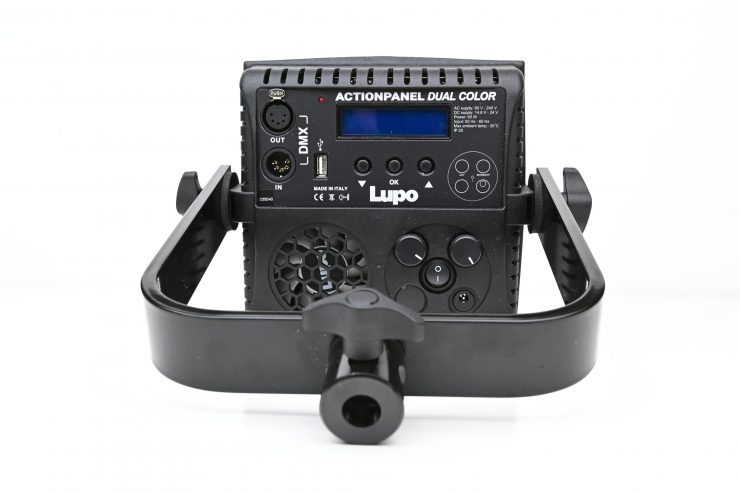
The Actionpanel Dual Color is Kelvin color adjustable from 3200K to 5600K. It has a claimed output of 13,000lx at a distance of 1m.
Key features
- Fixture Size: 8 x 8 x 4.1″
- Color Temperature: 3200 to 5600K
- Dimming: 0-100%
- CRI/TLCI: 96/98
Actionpanel Full Color
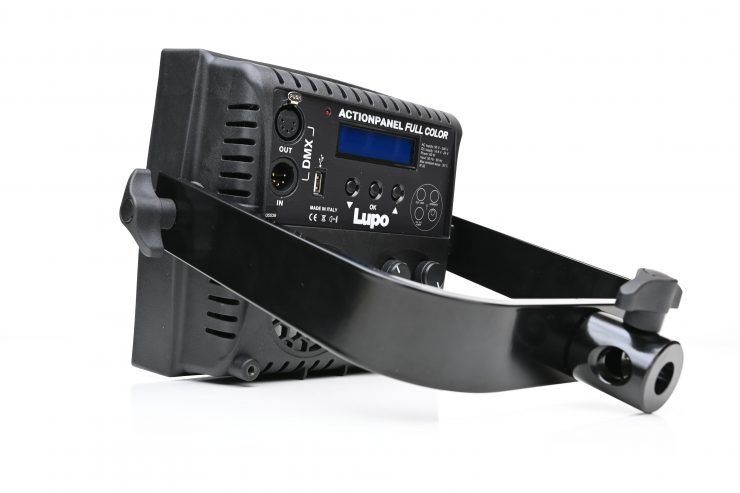
The Actionpanel Full Color is Kelvin color adjustable from 2800K to 10,000K and you can adjust green/magenta tint. The light has a claimed output of 5000lx at a distance of 1m. It also has the following modes:
- RGBWW
- HSI
- Preset & special Effects
- CCT
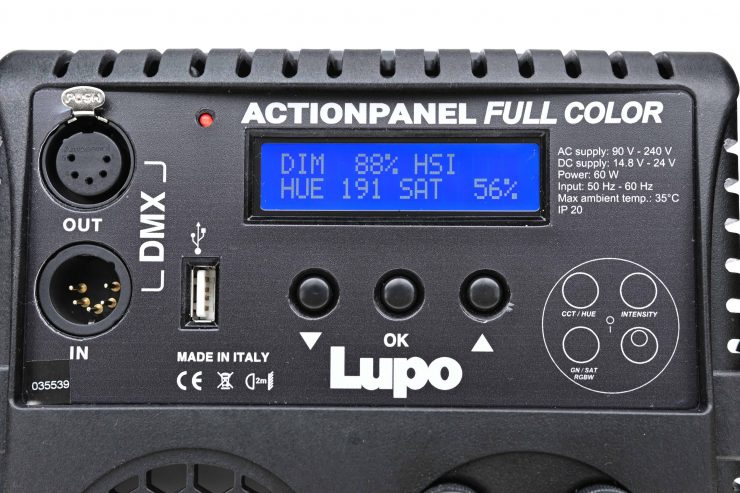
The Full Color version certainly is feature-packed and its modes allow you to create a variety of lighting effects.
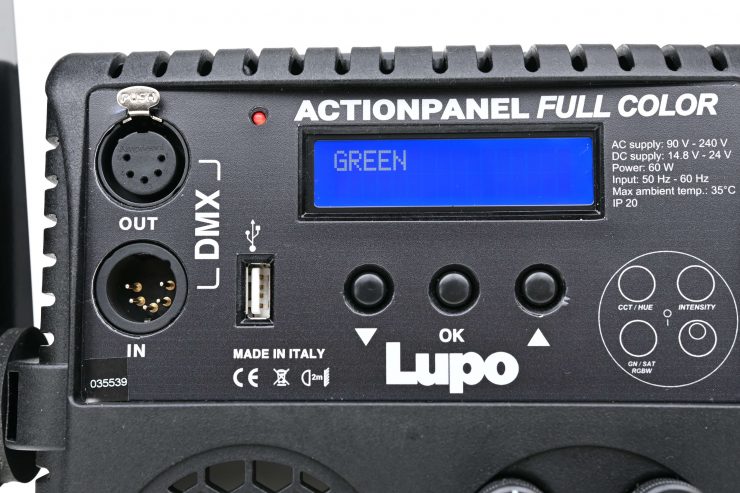
Not only is there an RGBWW Mode and an HSi Mode, but there is a large array of presets you can toggle through that allows you to jump straight to a particular color without having to go through all of the steps of trying to do it yourself.
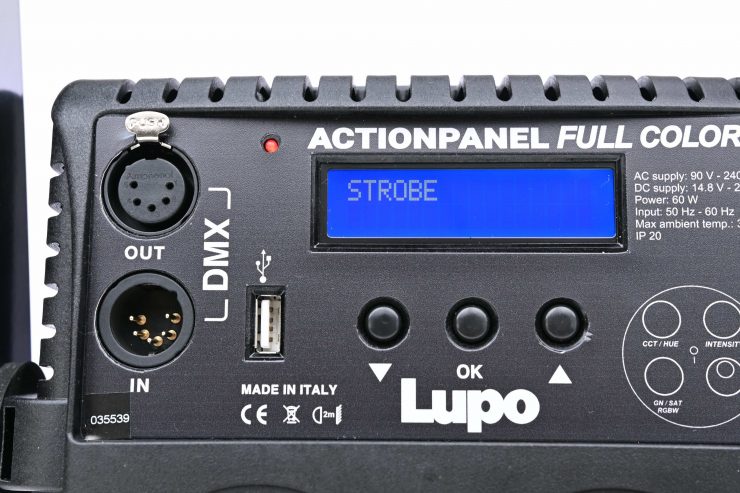
You can also bring up a range of in-built effects that you can fine-tune to create whatever look you are after.
Weight & Dimensions
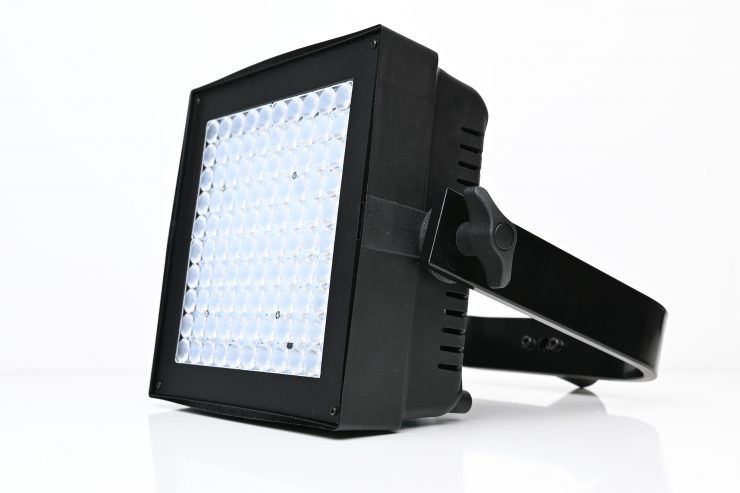
Both the Actionpanel Full Color and Dual Color have physical dimensions of 205 x 205 x 105 mm and weigh in at 2 kg (4.4 lb).
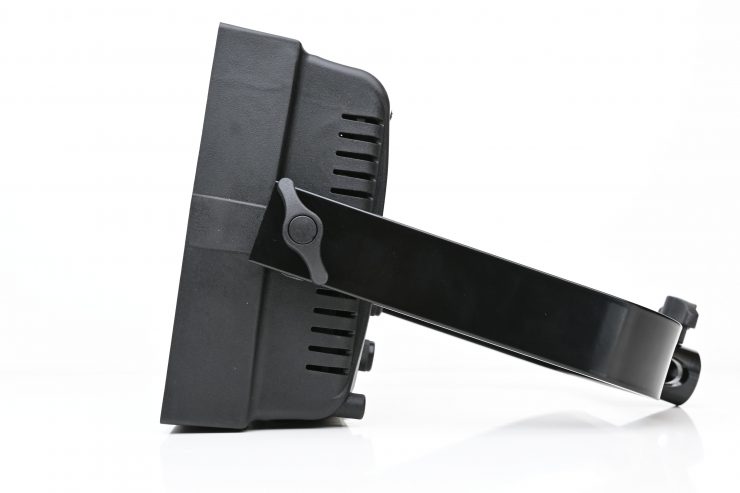
Despite the small size, they are still relatively thick at 105mm. This is actually just a fraction deeper than a 1×1 Superpanel Full Color fixture (100mm).
As a weight reference, the 1×1 Superpanel Full Color weighs in at 3.7kg.
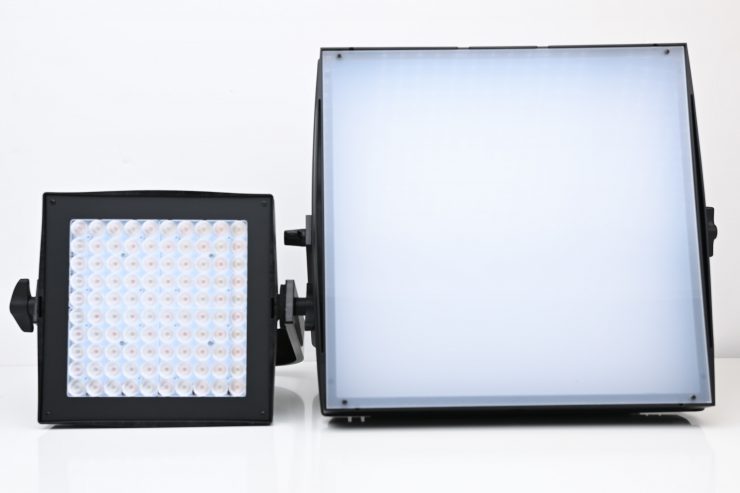
The physical dimensions make it around 39% smaller than a 1×1 Superpanel and 46% lighter.
Build Quality
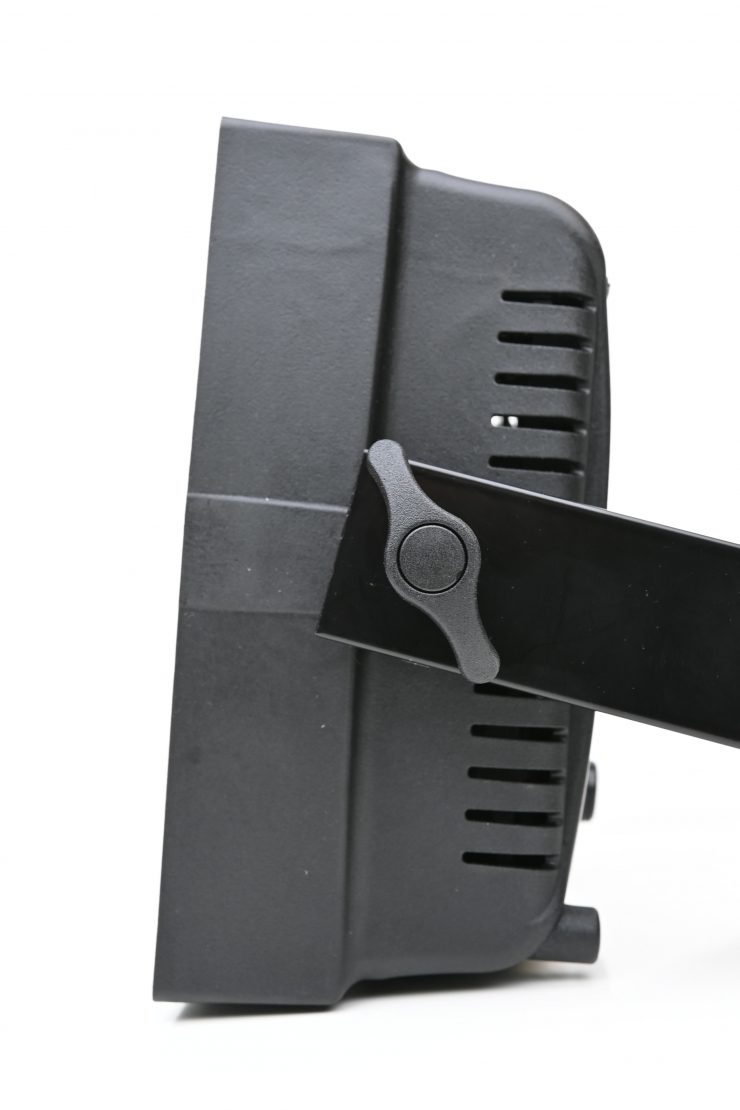
Like all Lupo lights, they concentrate on form and function rather than flash. The Actionpanel has the same industrial style looking design as all Lupo lights.
The casing of the fixture is made out of reinforced technopolymer and the light is nice and robust. It is matte black in color which is good because it doesn’t reflect any light. The only problem I found with the finish on the casing of the light is it is very prone to scratches. While this is more of a cosmetic issue, than a build quality issue, some potential buyers may not like this.
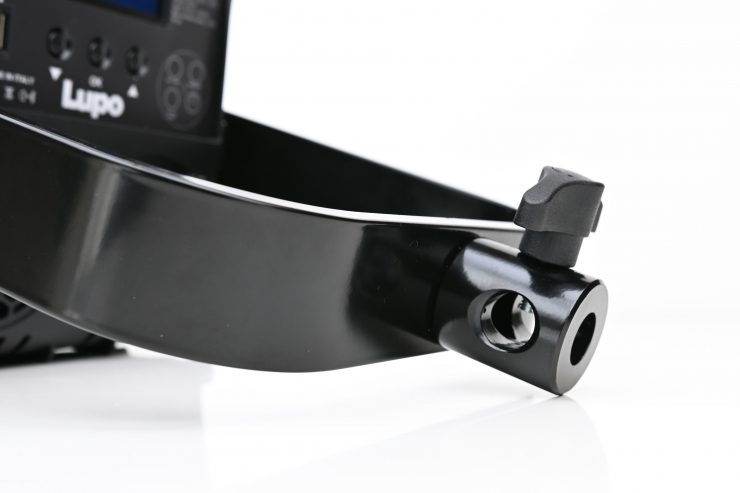
The yoke frame is solidly constructed and the locks on the yoke tighten down very securely. I was impressed with the size and thickness of the yolk frame.
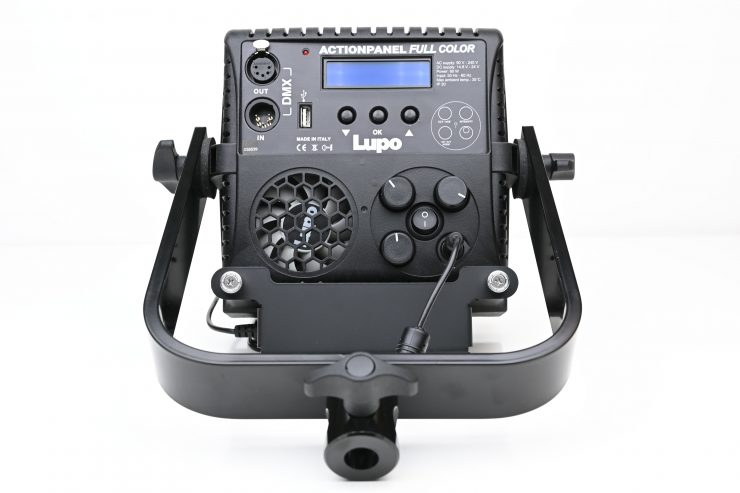
The power supply is nicely mounted beneath the fixture, but the cable that runs to it is long enough that you could remove it from the fixture if you were running the light out on a long arm and needed to keep the weight to a minimum.
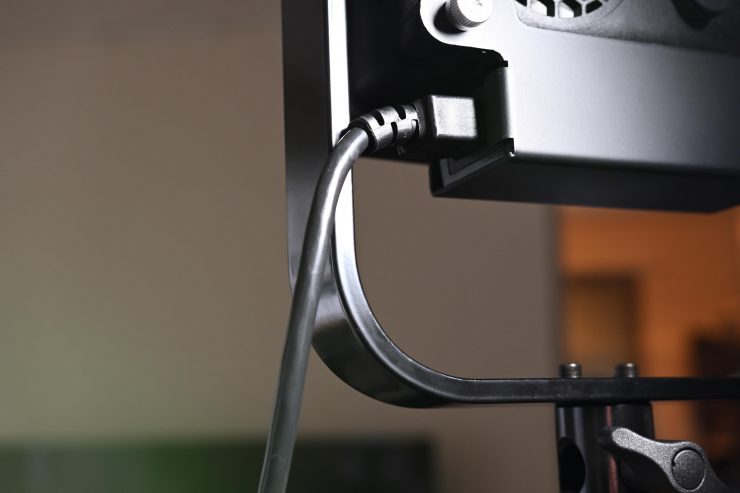
A design flaw that I found was that the power cable does end up hitting the yolk frame. While you can make it fit through when adjusting the angle on the yolk frame this is hardly ideal.
From using other Superpanel lights over the last three years I have yet to encounter a single problem when it comes to reliability or build quality. A lot of manufacturers (and I’m not sure if this applies to Lupo or not) are really pushing their LED lights to the limits and the lifespan of those fixtures can certainly be compromised.
I have had several LED panel lights (not Lupo’s) that ran really hot and ended up dying after only a year or so of use. If the LED light you are using is really hot to touch then there is a good chance it isn’t being cooled correctly and it could end up dying long before it should.
From my experience, I would much rather have a light with a fan than one that is passively cooled.
What do you get?
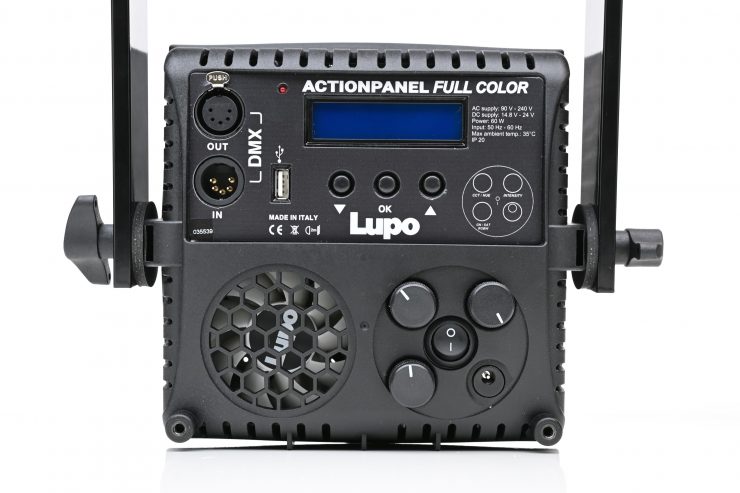
If you are just purchasing the light, you get the fixture, yolk frame, power supply, and power cable.
Lupo has kits available where you can get the Actionpanel in a backpack with a range of accessories. More on that later.
Power Draw
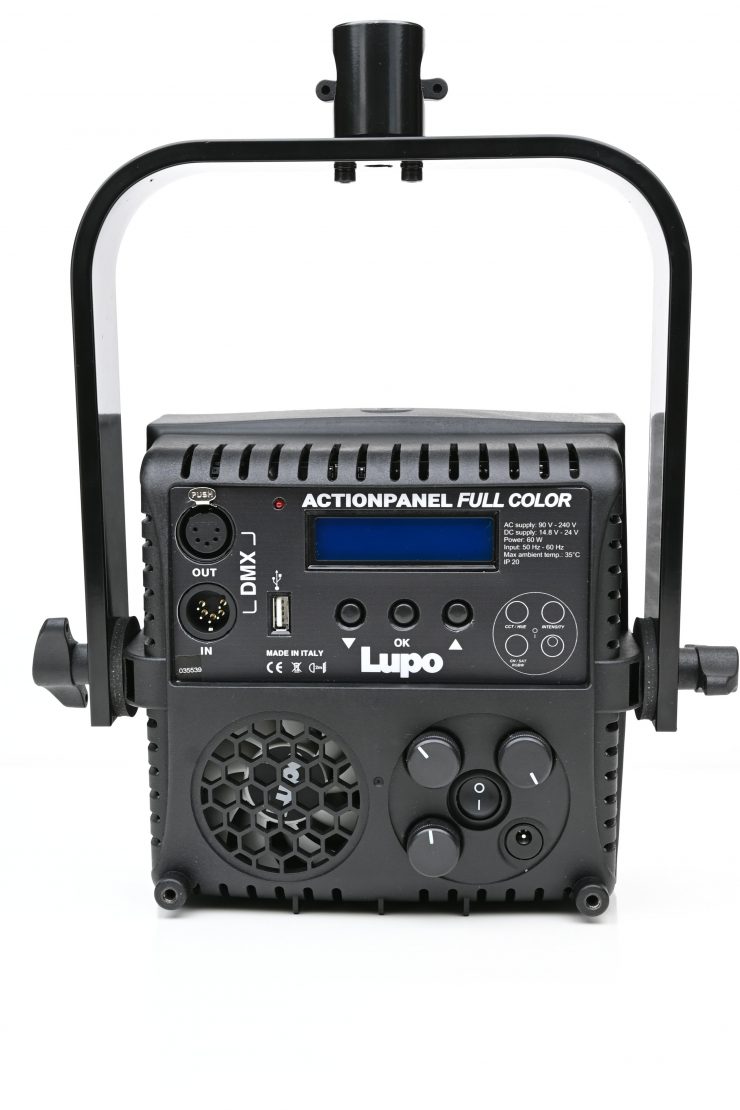
Both lights draw just 60W, which given their output, makes them a great choice for the traveling cameraman, especially if you need to run lights off batteries.
All the Actionpanel range models can be mains or battery operated (standard 14.8 V and 95 Wh batteries), and work through DMX control.
To me, the low power draw and high output makes this light a very compelling option if you require both of those things in a light that has a relatively small footprint.
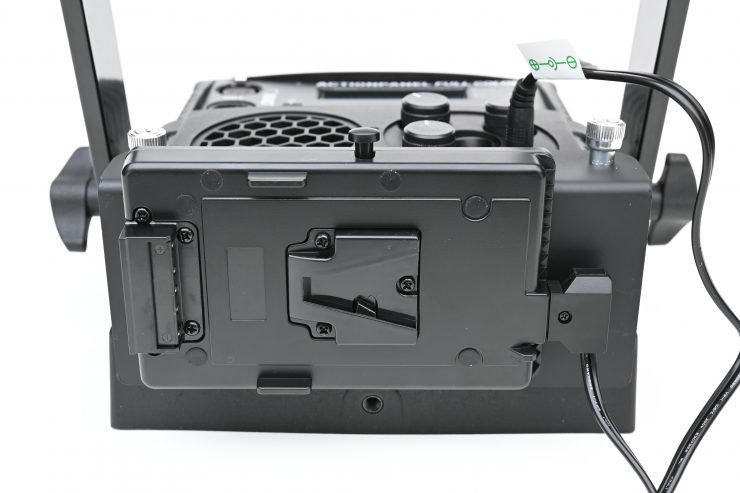
Now, unfortunately, you don’t get the battery plate as standard. The Lupo Battery Plate for Actionpanel LED Panel (V-Mount) costs an additional $79 USD. You also need to buy the D-tap power cable to use with V-Mount plate and that is an additional $28 USD. This makes no sense to me. You can’t use the V-Mount plate unless you have the D-tap cable, so why not just include it?
I would have liked to have seen both the V-mount plate and cable included for free as most people using a light like this are going to probably be running it off camera batteries a lot. If you don’t want to use a V-mount battery plate, you can also just use the D-tap power cable if you have a V-mount battery bracket of your own that you want to use.
If you do get the optional V-mount battery plate it attaches in the same place as where the power supply is mounted.
Display & Controls
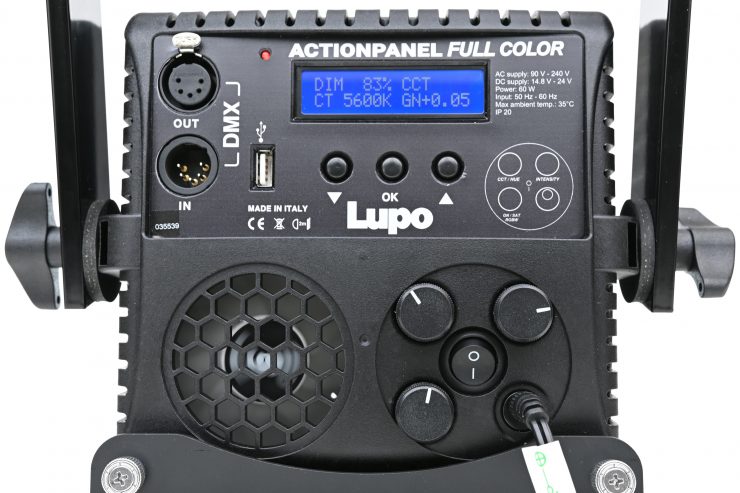
The controls and display on the Actionpanels are very similar to most other Lupo panel lights. The Actionpanels have a simple digital display on the back of the light that lets you see and make changes to the settings.
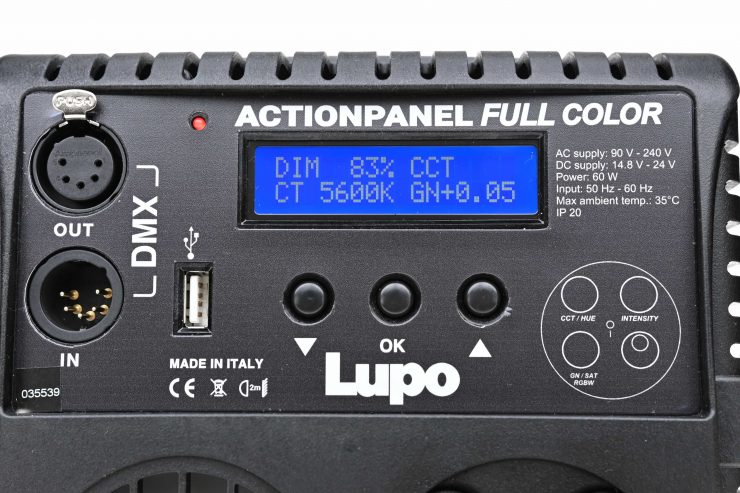
Controlling the intensity and Kelvin color temperature is simple to do and it is a light you can certainly use straight out of the box without referring to an instruction manual. Going into menus is a little bit more complicated and I wish Lupo had made this a little easier to do. It is a case of having to use button combinations to change settings that can be a bit confusing if you haven’t used a Lupo light before.
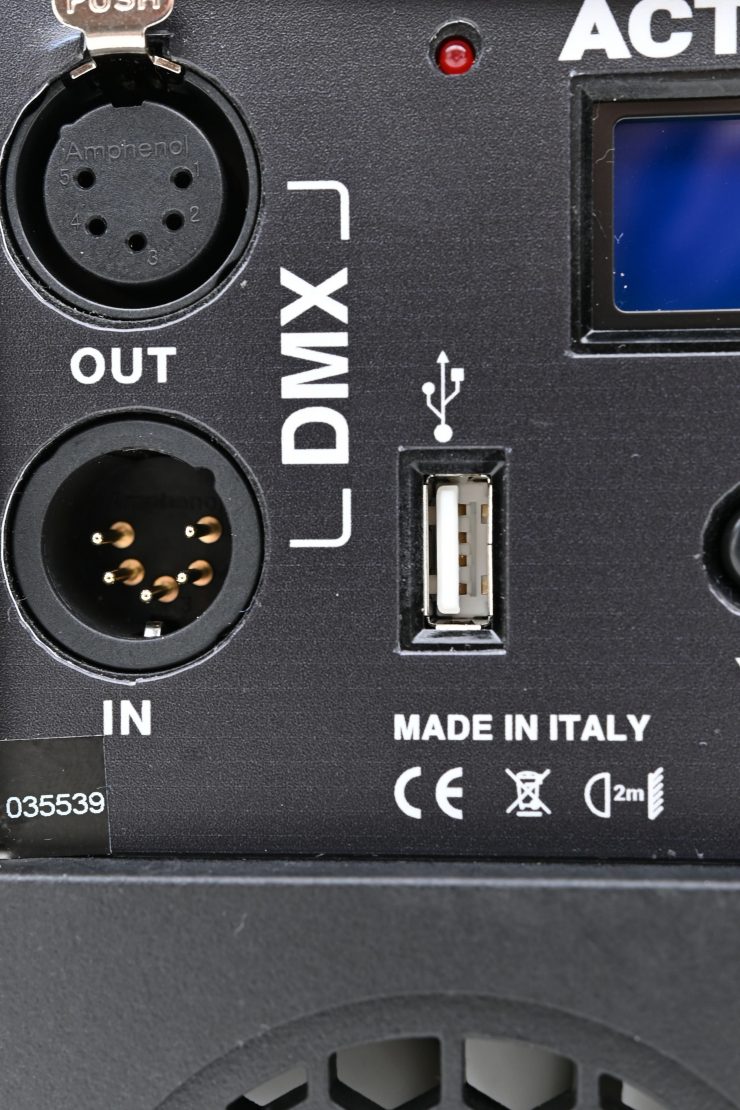
The lights have a recessed on/off switch, a color temperature adjustment dial, a DMX In and Out, a dimmer dial and a simple LCD display screen with three buttons.
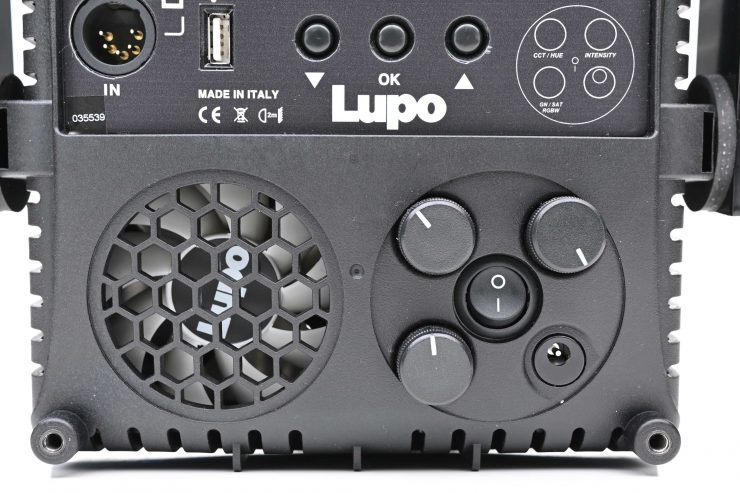
The Full Color version has one additional dial that is used for making the +/- green adjustments.
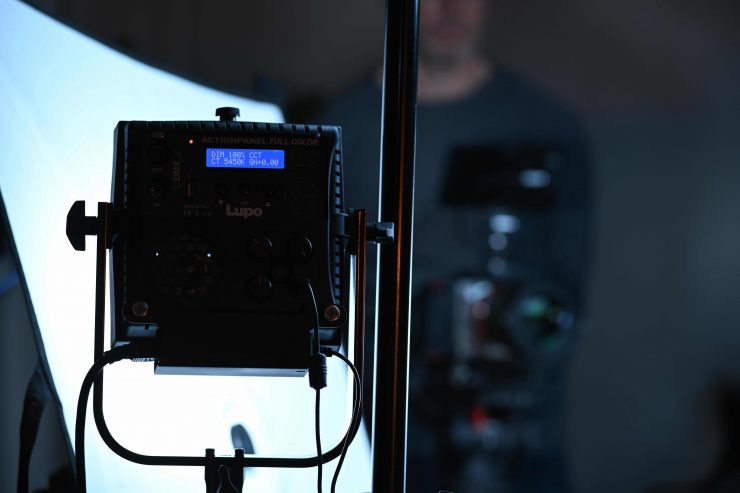
The lights are fully dimmable from 1-100% in one percent increments, and you can also adjust the kelvin range in one-kelvin increments for precise color temperature.
What I liked about the LED display is that you can set it to turn off after a select amount of time so you don’t emit any unnecessary light, this is handy if you are working in dark environments. By touching any of the dials or buttons the display’s brightness comes back on.
The lights have a 1/4 20″ threaded hole on the top and the bottom of the light for attaching the optional barn doors.
Fan
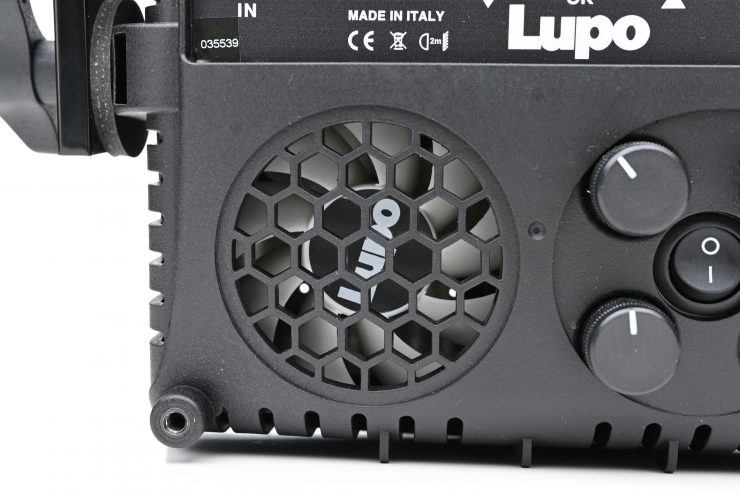
Both versions of the Actionpanel have in-built fans. They are relatively quiet, but if you do need to turn them off you can.
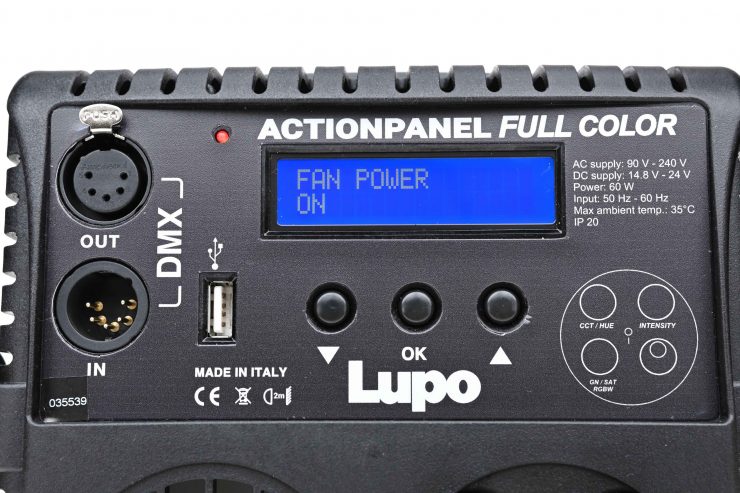
If you do turn the fan off then the lights will only run at 50%.
One thing that does slightly concern me is that on the fixture it says that the Max. ambient temperature the lights can be used at is 35C (95F). I did encounter a problem where I was shooting indoors and the light was right near a heater that was blowing hot air into the back of the light. The light’s fan was then sucking that hot air into the fixture. It shut off and came up with a temperature error. Once I realized what was happening I turned the heater off in the room that was causing the problem and that solved it.
Beam Angle
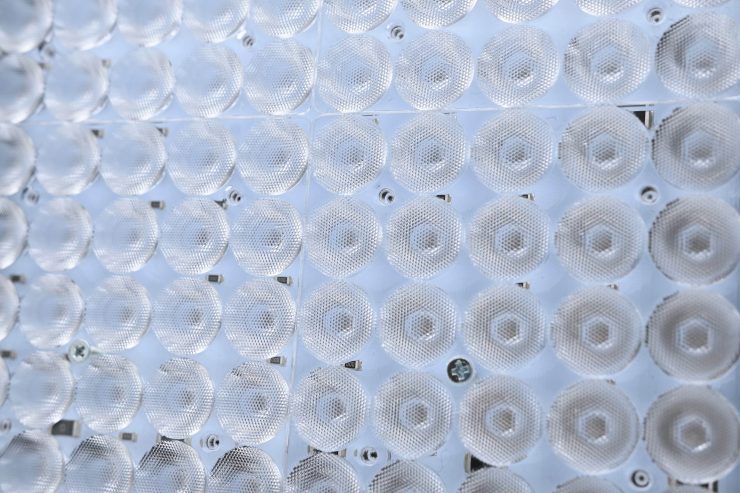
The beam angle of the Dual Color is quite narrow. It is 40 degrees for both versions of the Actionpanel. While this is good for interview scenarios or situations where you don’t want excessive light spill, some people may find it a little limiting.
Photometrics
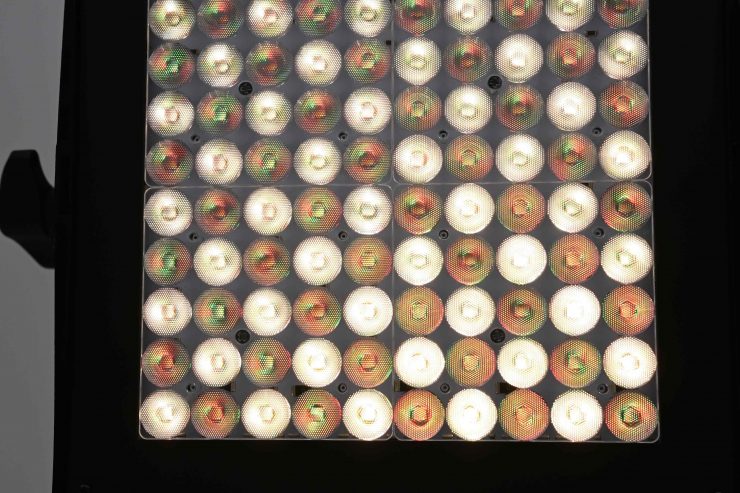
So now let’s get to the photometric results. I always test lights in this way so that I get a reference to how they compare to other fixtures. Results only tell part of the story and should never be used alone to judge a light. I have found from extensive testing over the years that certain lights that have good photometric results don’t always look good, and lights that have worse photometric scores can sometimes look better than their results indicate.
Output & Kelvin Color Temperature Accuracy
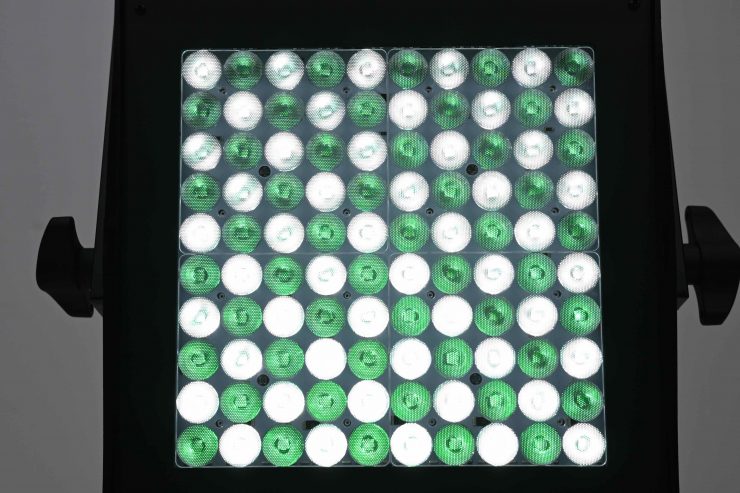
I tested the Lupo Actionpanel Full Color and Dual Color at a variety of Kelvin color temperatures with a Sekonic C-800 Spectrometer to find out how much output the light had and how accurate the Kelvin color temperature reproduction was. All readings are taken at a distance of 1m (3.28ft) in a controlled environment.
5600K
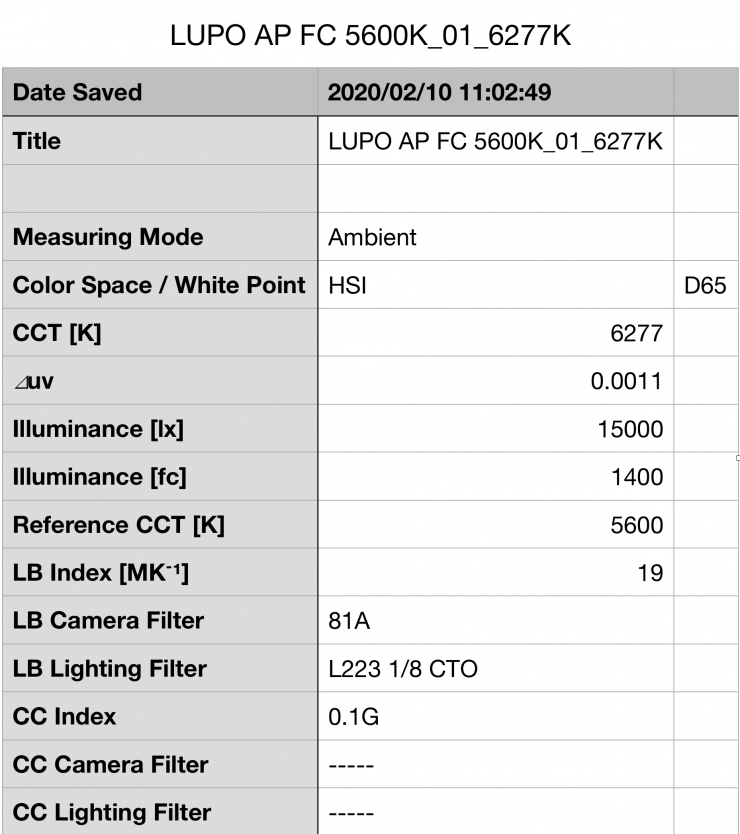
Above you can see the Dual Color recorded an output of 15,000 lx 1400 (fc) when set at 5600K and run off mains power. This output was extremely impressive for a fixture of this size that only draws 60 watts. In saying that, you do need to remember that the beam angle is quite narrow.
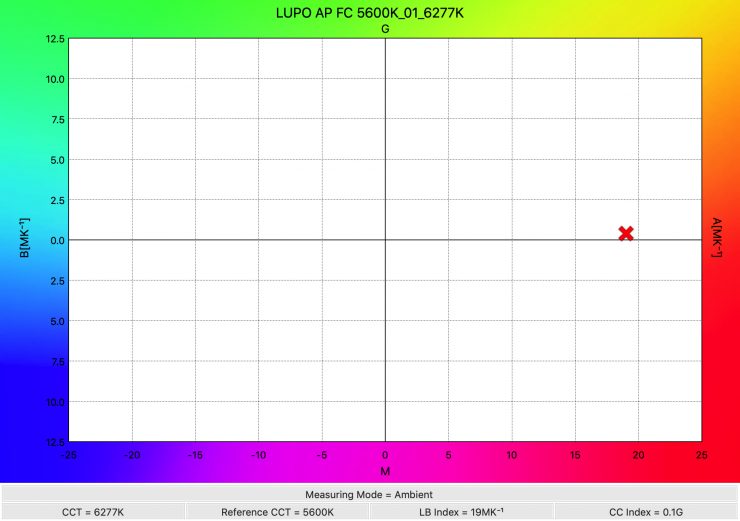
The Lupo produced a Kelvin color temperature of 6277K. The Superpanel had a 0.1G CC Index score. The 6277K reading was a lot higher than what I would have liked to have seen when using this light at 5600K.
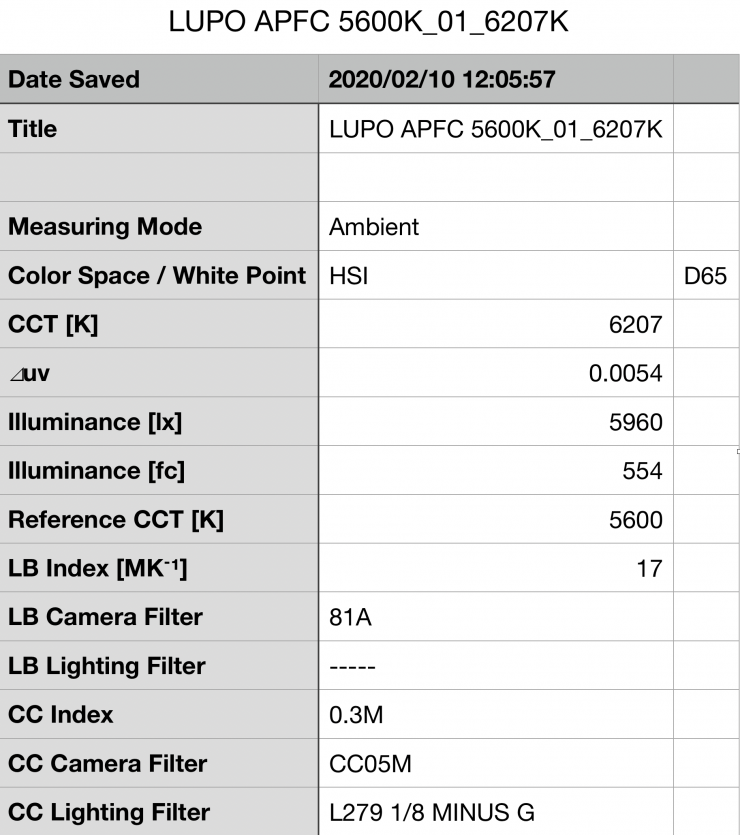
Above you can see the Full Color version recorded an output of 5,960 lx 554 (fc) when set at 5600K and run off mains power.
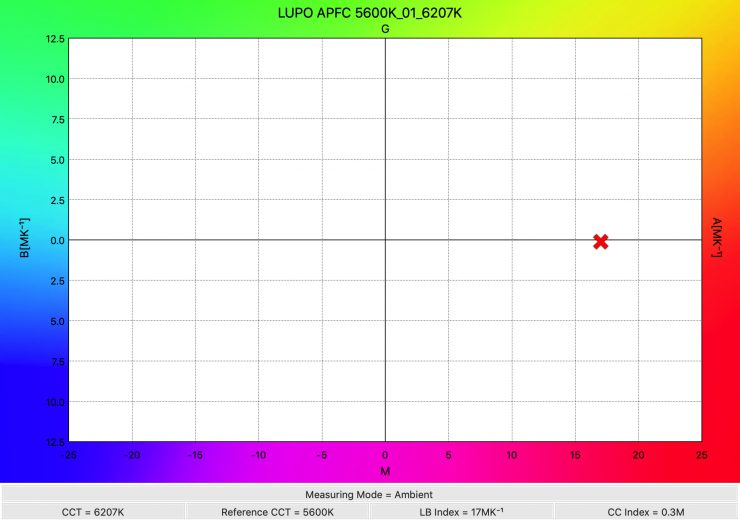
The Lupo produced a Kelvin color temperature of 6207K. The Full Color had a 0.3M CC Index score.
This output was impressive for an RGBW fixture of this size that only draws 60 watts. The 6207K reading was a lot higher than what I would have liked to have seen when using this light at 5600K.
In saying that, as the Full Color has +/- Green adjustment is reasonably easy to get a 0 CC Index score.
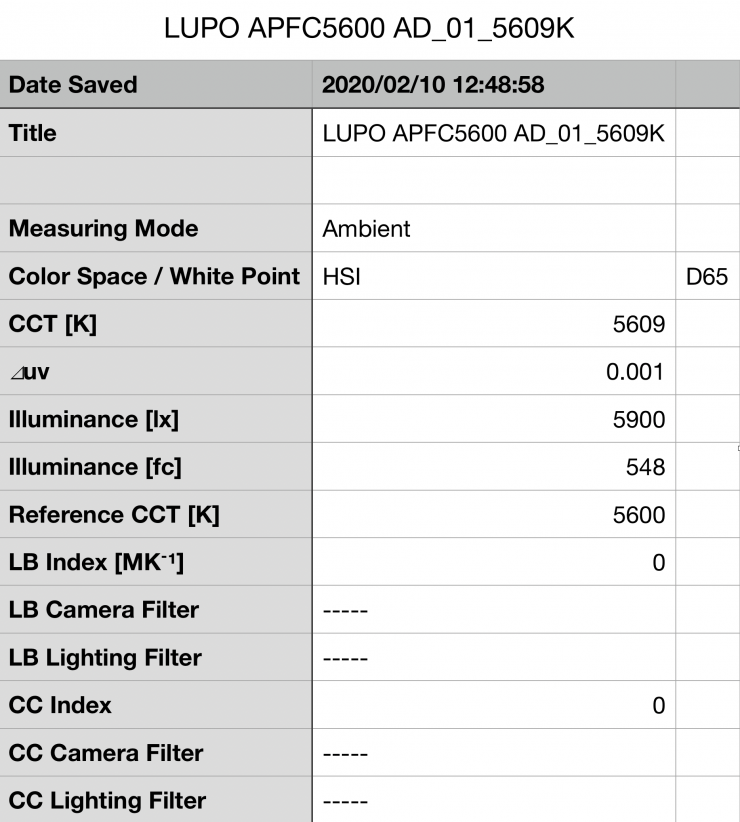
If I set the light at 5150K and put in -0.17 Green I could get a Kelvin color temperature reading of 5609K and a 0 CC Index score. This just goes to show you how important it is to be able to measure a light and then fine-tune it to get the most accurate results.
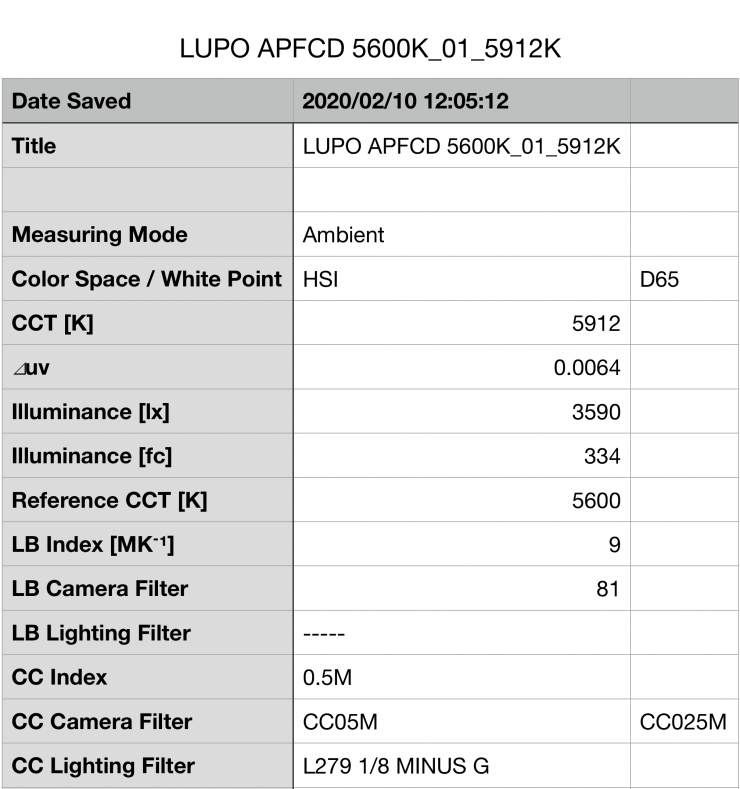
I also recorded figures when attaching the optional diffusion box. The Actionpanel Full Color recorded an output of 3,590 lx 334 (fc) when set at 5600K and run off mains power.
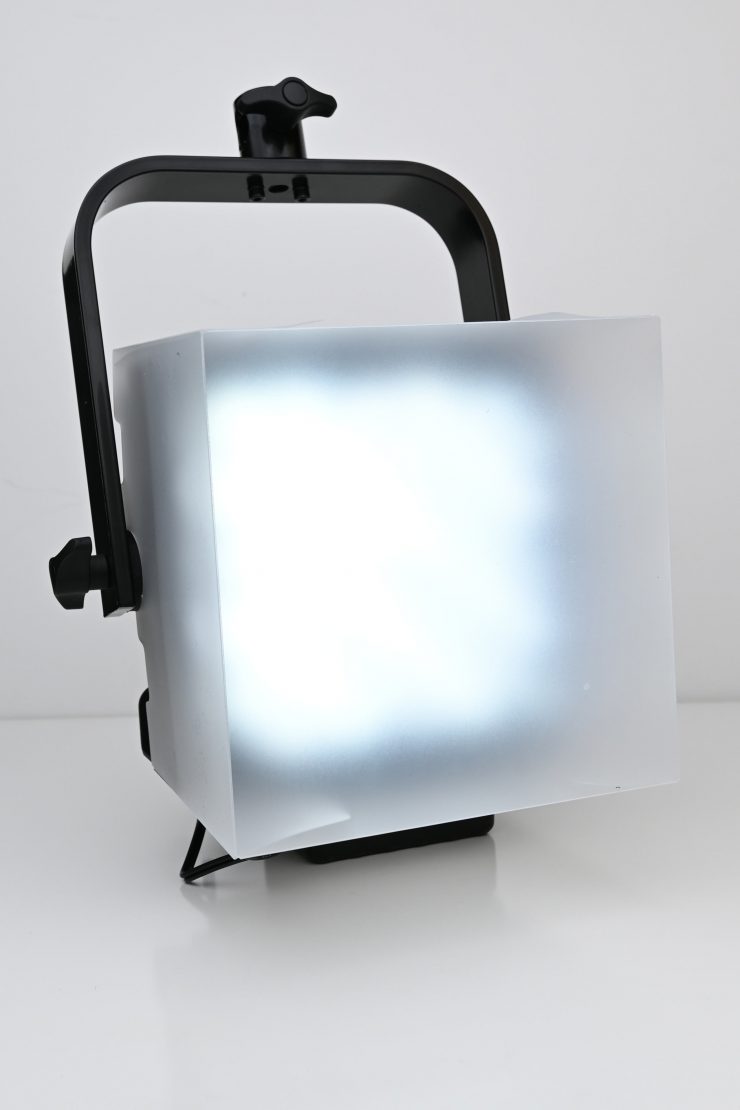
This was a decrease of just under 40% when compared to not using the diffusion box.
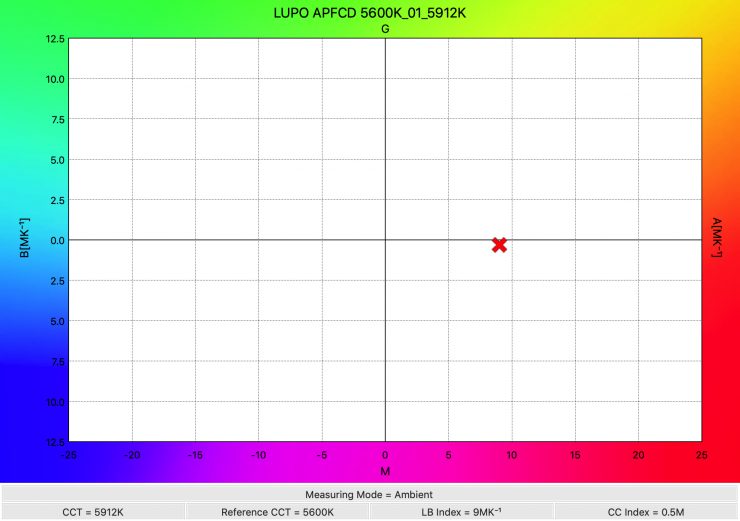
Interestingly enough the light recorded a better Kelvin color temperature of 5912K when using the diffusion box than it did without using having it on.
As a competition comparison, the Rayzr MC100 Multi Color RGBWW Soft LED Panel Light recorded an output of 2170 lx 201 (fc) when set at 5600K and run off mains power. The light produced a Kelvin color temperature of 5516K. The fixture had a 0.4M CC Index score. The Rayzr’s output is 63% less. What you need to keep in mind is that the Rayzr has a built-in diffusion panel and the Lupo does not. The beam angle of the Rayzr is 120 degrees, while the Lupo is a lot narrower. The Rayzr draws 98W as opposed to the Lupo’s 60W.
In some ways, it is hard to compare the Rayzr MC 100 and the Lupo Actionapanel Full Color. I am primarily making this comparison because it is one of the only other light I have reviewed that is similar.
3200K
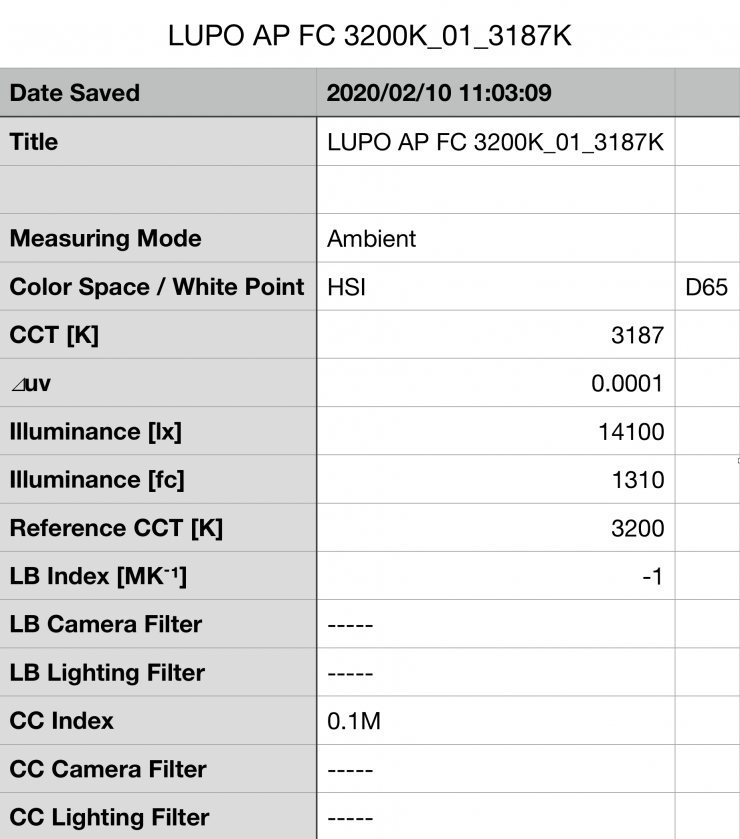
Above you can see the Actionpanel Dual Color recorded an output of 14,100 lx 1310 (fc) when set at 3200K and run off mains power.
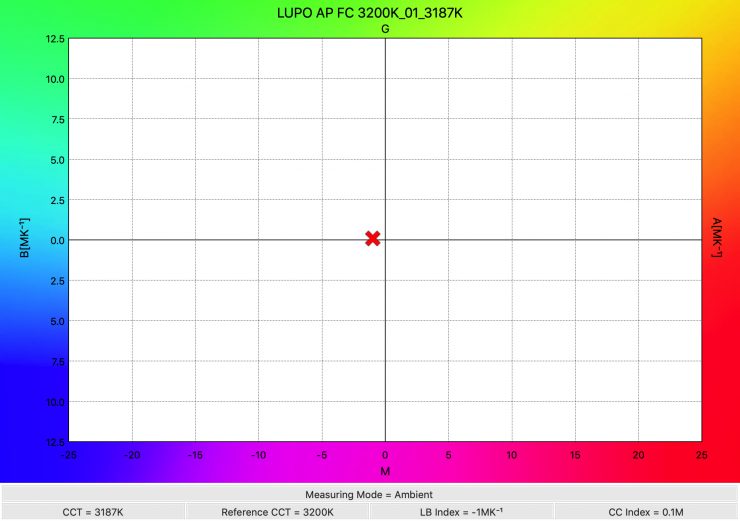
The light produced a Kelvin color temperature of 3187K. The fixture had a 0.1M CC Index score. Again, this output was extremely impressive for any fixture this size, and at 3200K its output is only 6% lower than when used at 5600K. The 3187K reading was very accurate, and this was a lot better than when the light is used at 5600K.
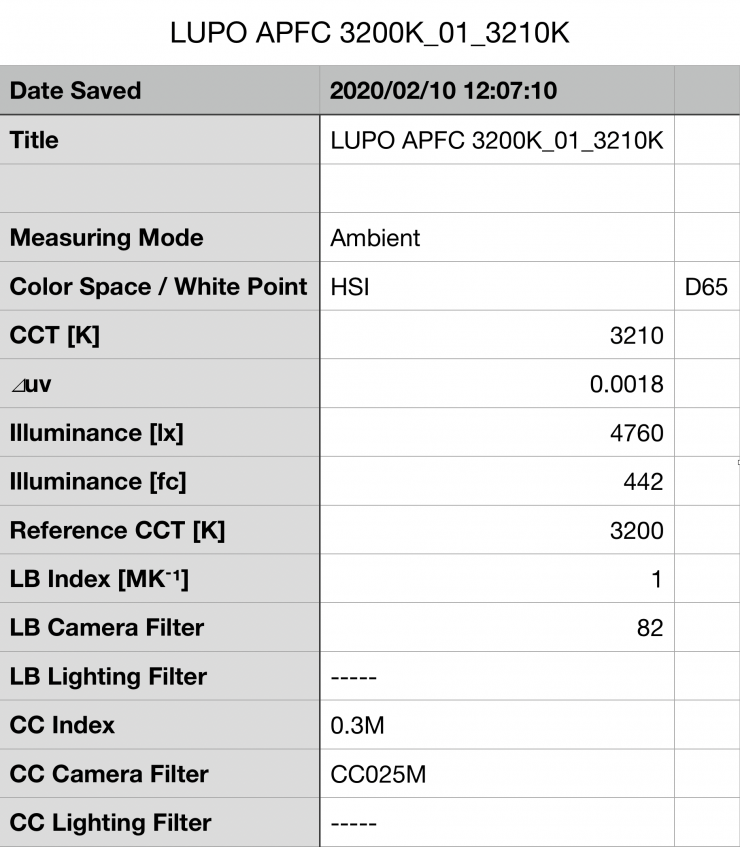
Above you can see the Actionpanel Full Color recorded an output of 4,760 lx 0 442 (fc) when set at 3200K and run off mains power.
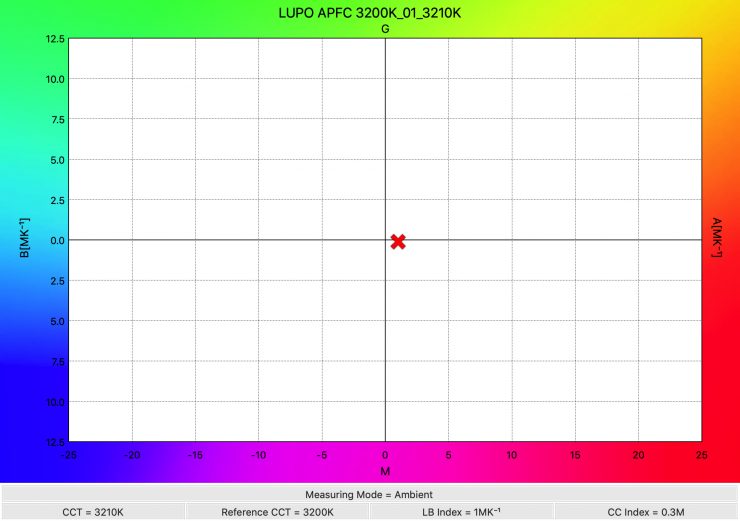
The light produced a Kelvin color temperature of 3210K. The fixture had a 0.3M CC Index score. Again, this output was impressive for any fixture this size, and at 3200K its output was 20% lower than when used at 5600K. The 3210K reading was extremely accurate, and this was a lot better than when the light is used at 5600K.
As a comparison, the Rayzr MC100 Multi Color RGBWW Soft LED Panel Light recorded an output of 1920 lx 0 178 (fc) when set at 3200K and run off mains power. The light produced a Kelvin color temperature of 3298 K. The fixture had a 0.5M CC Index score. Its output is just under 60% less than that of the Lupo. To be fair, if you compare the Lupo with the optional diffusion box against the MC100, the Rayzr has around 40% less output when used at 3200K.
I also measured the Dual Color and Full Color at 4500K. For the Full Color I also did additional measurements at 2800K, 6500K, and 10,000K.
Summary of output and Kelvin color temperature results of Actionpanel Dual Color (all results recorded at a distance of 1 meter):
| LUX | FC | Kelvin Color Temperature | |
| 3200K | 14,100 lx | 1310 fc | 3187K |
| 4500K | 13,000 lx | 1200 fc | 4463K |
| 5600K | 15,000 lx | 1400 fc | 6277K |
These results show me that the light drops output when you start moving the Kelvin temperature dial down from 5600K, but not by a massively large amount. The output of the light is extremely impressive. The Kelvin color temperate accuracy of the light could be better when it is used at 5600K. It is a lot more accurate when set at 4500K and 3200K.
Summary of output and Kelvin color temperature results of Actionpanel Full Color:
| LUX | FC | Kelvin Color Temperature | |
| 2800K | 5240 lx | 487 fc | 2956K |
| 3200K | 4760 lx | 442 fc | 3210K |
| 4500K | 5580 lx | 519 fc | 4592K |
| 5600K | 5960 lx | 554 fc | 6207K |
| 6500K | 5830 lx | 542 fc | 7107K |
| 10,000K | 6630 lx | 616 fc | 13,172K |
These results show me that the light drops output when you start moving the Kelvin temperature dial down from 5600K, but not by a massively large amount. Strangely, the light had less output at 3200K than at 2800K. The output of the light is extremely impressive. The Kelvin color temperate accuracy of the light could be better when it is used at 5600K and above. It is a lot more accurate when set at 4500K and below. In saying that, it is relatively easy to get much better results and more accurate Kelvin color temperature readings by making adjustments to the light.
So how much does the light output when running off camera batteries?
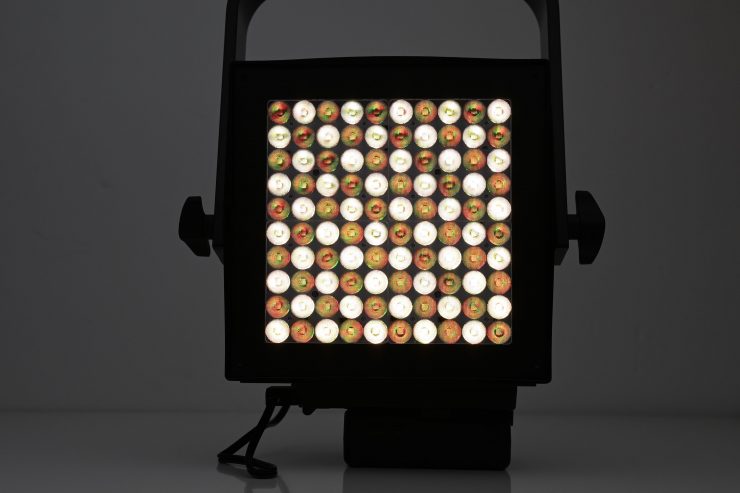
You can’t just assume that a light running off camera batteries will output the same as it does when being run off mains power. I wanted to see if the output of the light changed if you ran it off camera batteries.
The Full Color recorded an output of 4600 lx 4150 (fc) when set at 5600K and running off a camera battery. This output was around 23% less than when running off mains power
The Dual Color recorded an output of 11,100 lx when set at 5600K and running off camera batteries. While this output was impressive for any light running off a camera battery. This output was 26% less than when running off mains power.
It is important to remember that you won’t get the same amount of output when running the Actionpanels off camera batteries. Luckily the lights already have such a good output that this loss in output is not a deal-breaker.
Color Rendering
So now that we have seen how much output the Lupo Actionpanel’s produce, how do they perform when it comes to replicating accurate colors. Will the high output effect color rendering performance? Well, let’s find out.
5600K
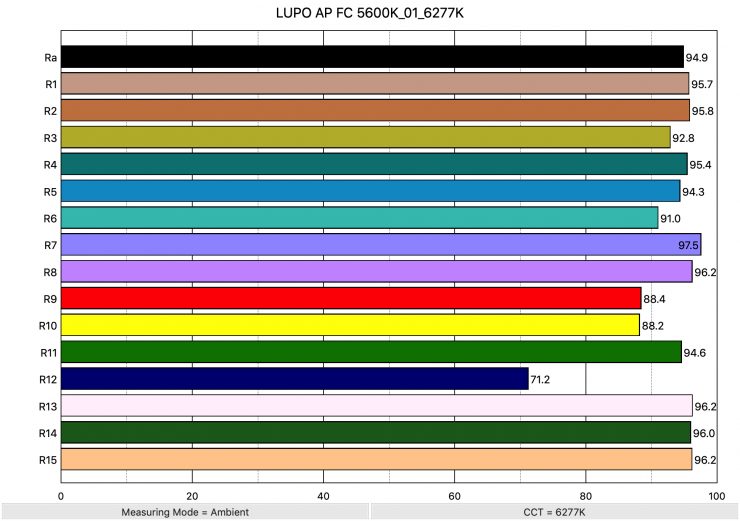
Above you can see that when the Dual Color was set at 5600K it recorded an average CRI (R1-R8) of 94.9 and an extended CRI (R1-R15) of 92.63. For replicating accurate skin tones it recorded 88.4 for R9 (red), 96.2 for R13 (closest to caucasian skin tones), and 96.2 for R15 (closest to Asian skin tones). These were all good results. You can see the low score for R12 (blue), and that is why this light has a slight push towards magenta and a higher than expected Kelvin color temperature.
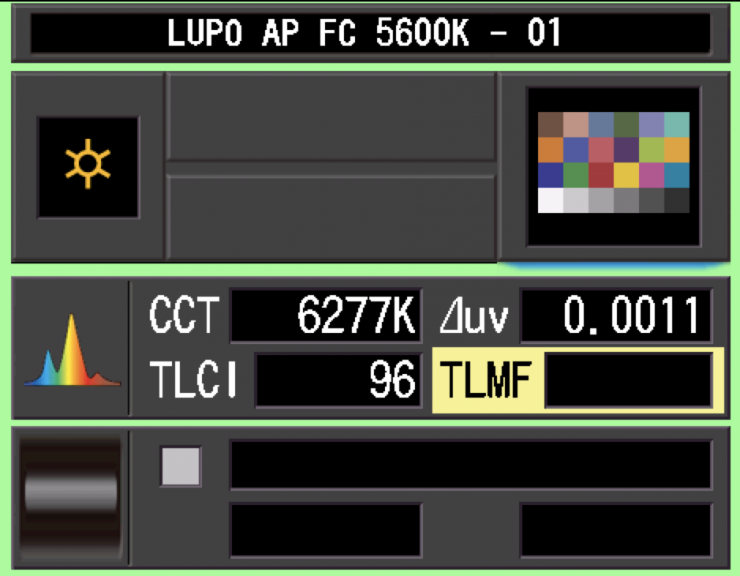
The light when set at 5600K also recorded a TLCI score of 96. It also recorded the same score when used at 3200K.
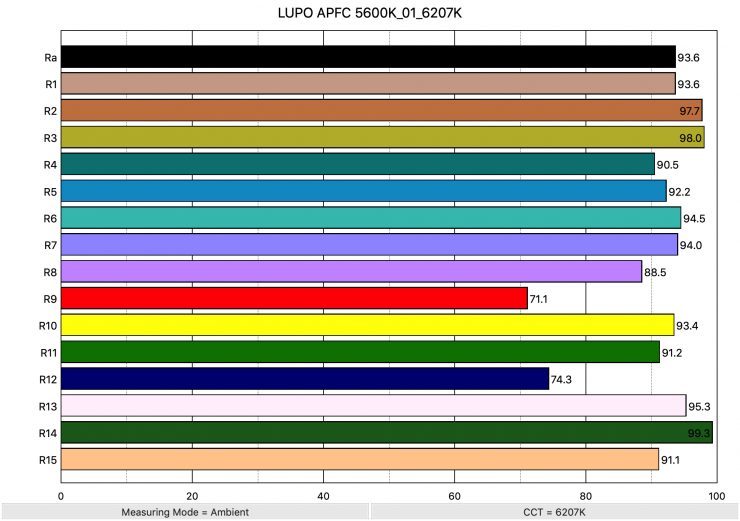
Above you can see that when the Full Color was set at 5600K it recorded an average CRI (R1-R8) of 93.6 and an extended CRI (R1-R15) of 90.98. For replicating accurate skin tones it recorded 71.1 for R9 (red), 95.3 for R13 (closest to caucasian skin tones), and 91.1 for R15 (closest to Asian skin tones). These results were ok, but they weren’t great.
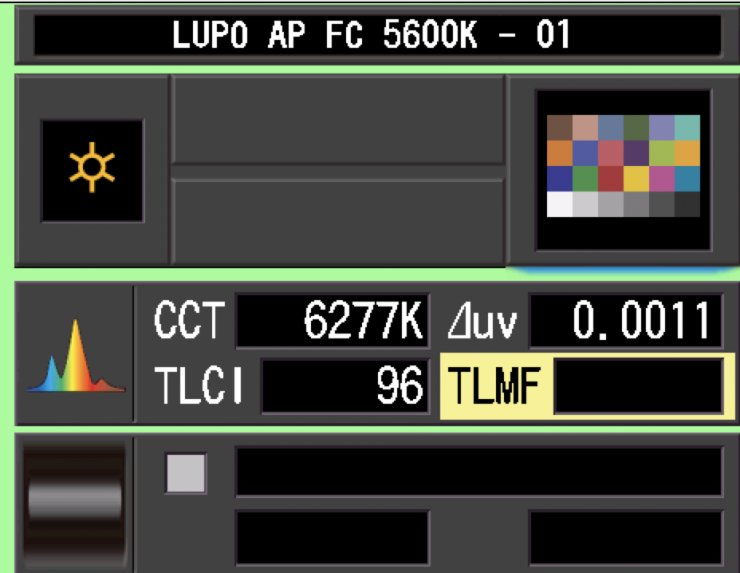
The light when set at 5600K also recorded a TLCI score of 96. It also recorded the same score when used at 3200K.
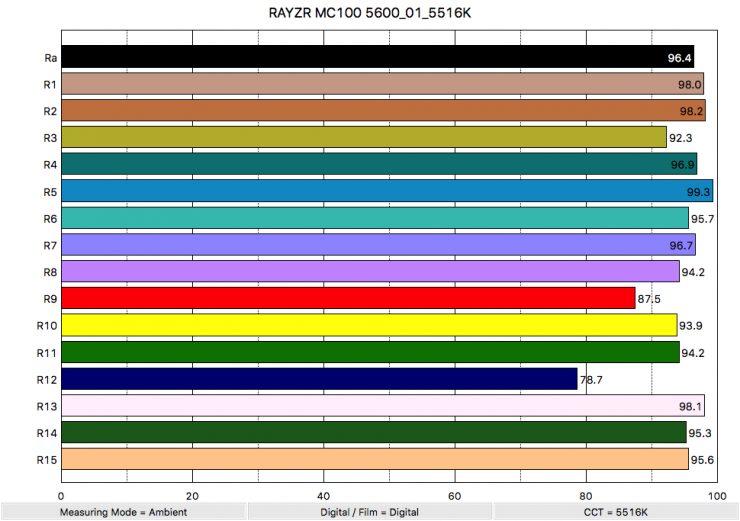
So how does that compare to a smaller sized panel light like the Rayzr MC100 Multi Color RGBWW Soft LED Panel Light? Above you can see that when the light was set at 5600K it recorded an average CRI (R1-R8) of 96.4 and an extended CRI (R1-R15) of 94.30. For replicating accurate skin tones it recorded for R9 87.5 (red), 98.1 for R13 (closest to caucasian skin tones), and 95.6 for R15 (closest to Asian skin tones). These are pretty good results are pretty good, and better than thse of the Lupo Actionpanel Full Color when used at 5600K.
3200K
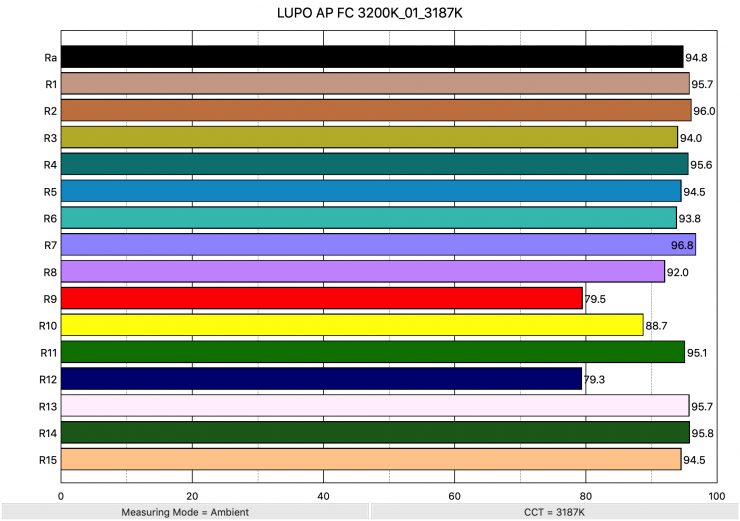
Above you can see the scores for Dual Color when it was used at 3200K. It recorded an average CRI (R1-R8) of 94.8 and an extended CRI (R1-R15) of 92.46. For replicating accurate skin tones it recorded 79.5 for R9 (red), 95.7 for R13 (closest to caucasian skin tones), and 94.5 for R15 (closest to Asian skin tones). These results were pretty good, but the scores for R9 and R12 could be higher.
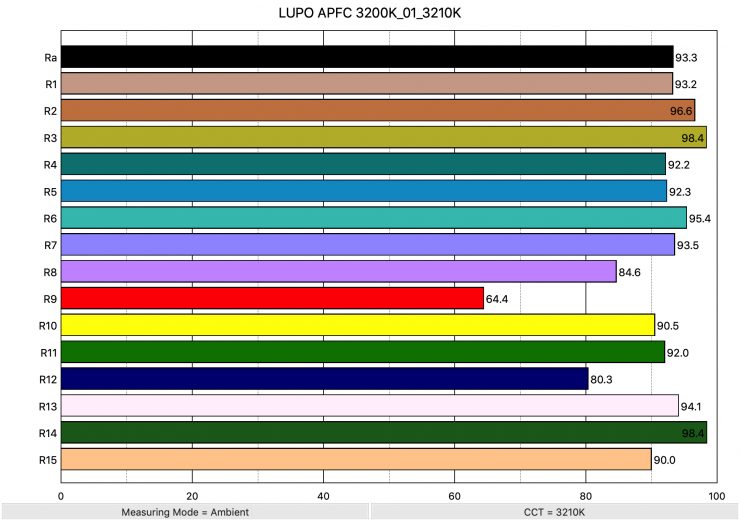
Above you can see the scores for Full Color when it was used at 3200K. It recorded an average CRI (R1-R8) of 93.3 and an extended CRI (R1-R15) of 90.39. For replicating accurate skin tones it recorded 81.3 for R9 (red), 97.3 for R13 (closest to caucasian skin tones), and 96 for R15 (closest to Asian skin tones). These results were not as good as I was expecting. In saying that, any scores in the 90s is good.
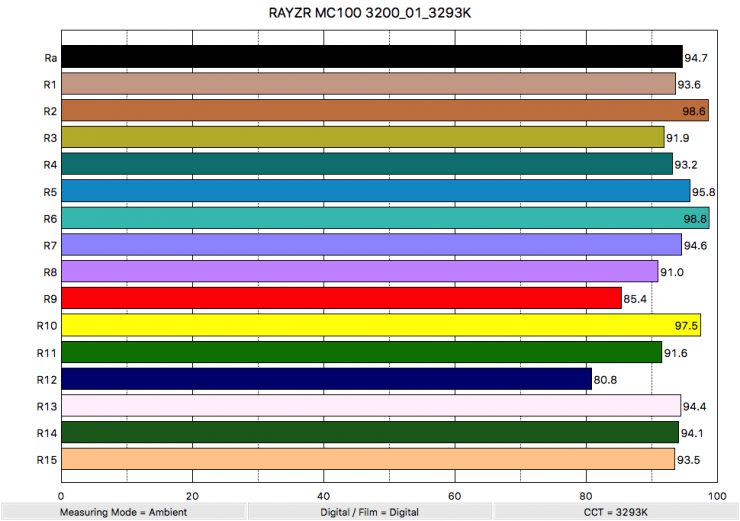
So how does that compare to a smaller sized panel light like the Rayzr 7 MC100 Multi Color RGBWW Soft LED Panel Light? Above you can see that when the light was set at 3200K it recorded an average CRI (R1-R8) of 94.7 and an extended CRI (R1-R15) of 86.74. For replicating accurate skin tones it recorded 85.4 for R9 (red), 94.41 for R13 (closest to caucasian skin tones), and 93.5 for R15 (closest to Asian skin tones). The Lupo has better color rendering scores when used at 3200K.
SSI
SSI (Spectral Similarity Index) was developed by the Sci-Tech Council of the Academy. SSI gives me the ability to set any light as a standard, or use predefined standards (such as CIE D55), and then give other lights an SSI score based upon how well they will match standards such as CIE D55 measure spectral response and compare it directly against an ideal light source.
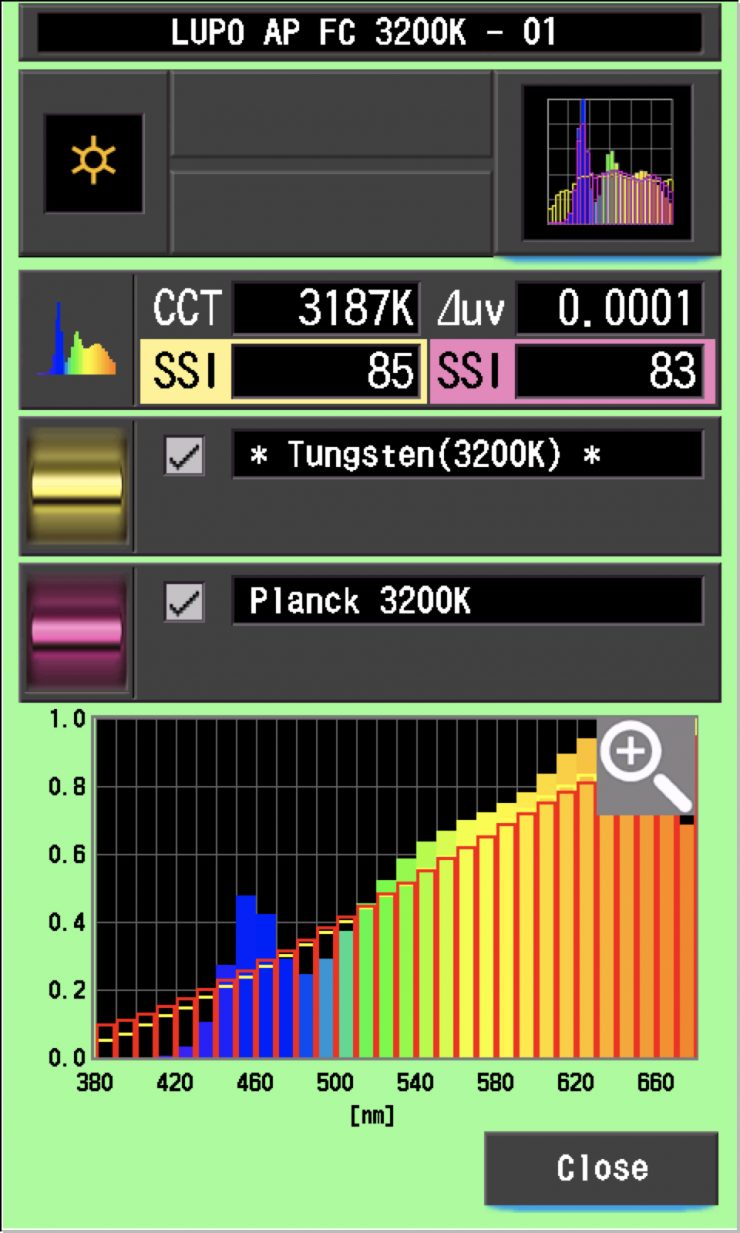
In this graph the Gold bars indicate a perfect 3200 (Tungsten source. The Red bars indicate a Planck 3200K source. This lets us compare how close to a perfect 3200k lighting source the Lupo is. A score in the low to mid-80s is very good for a 3200K LED light.
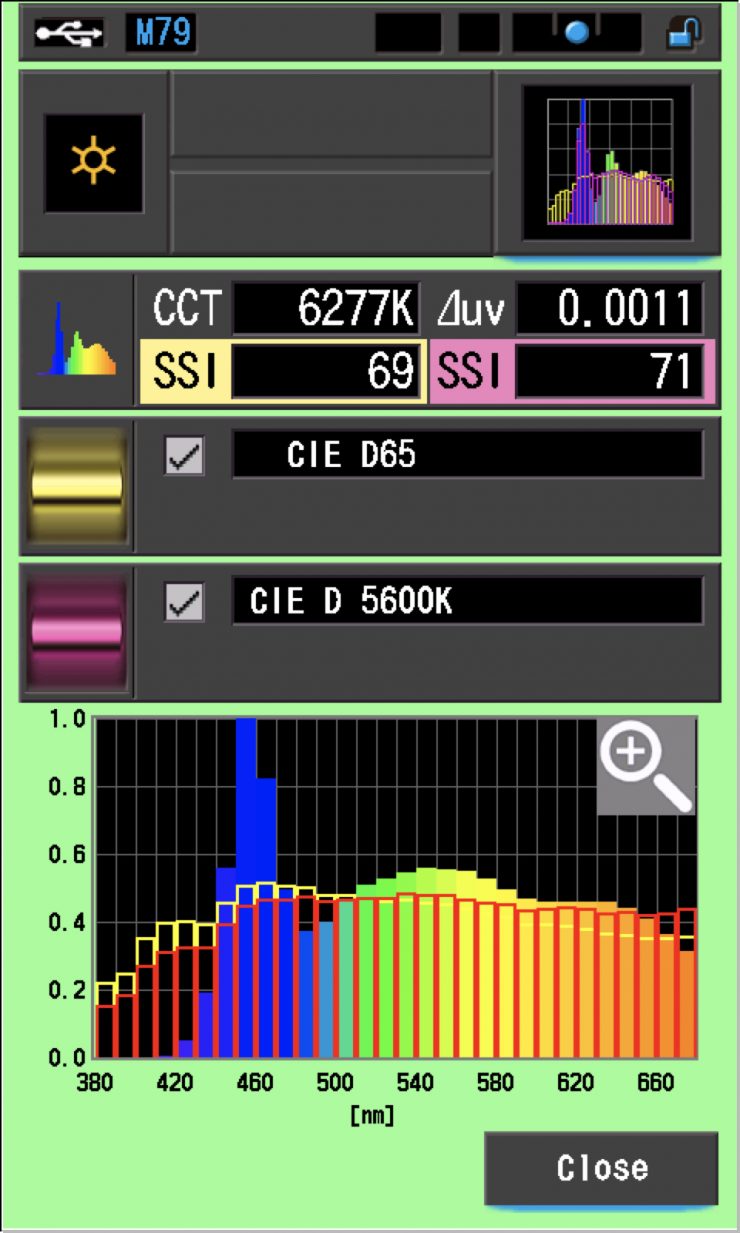
In this graph above the gold bars indicate a perfect D65 source. The Red bars indicate a 5600K source. This lets us compare how close to a perfect 3200k lighting source the Lupo is. A score in the low 70’s is very common for most 5600K LED sources.
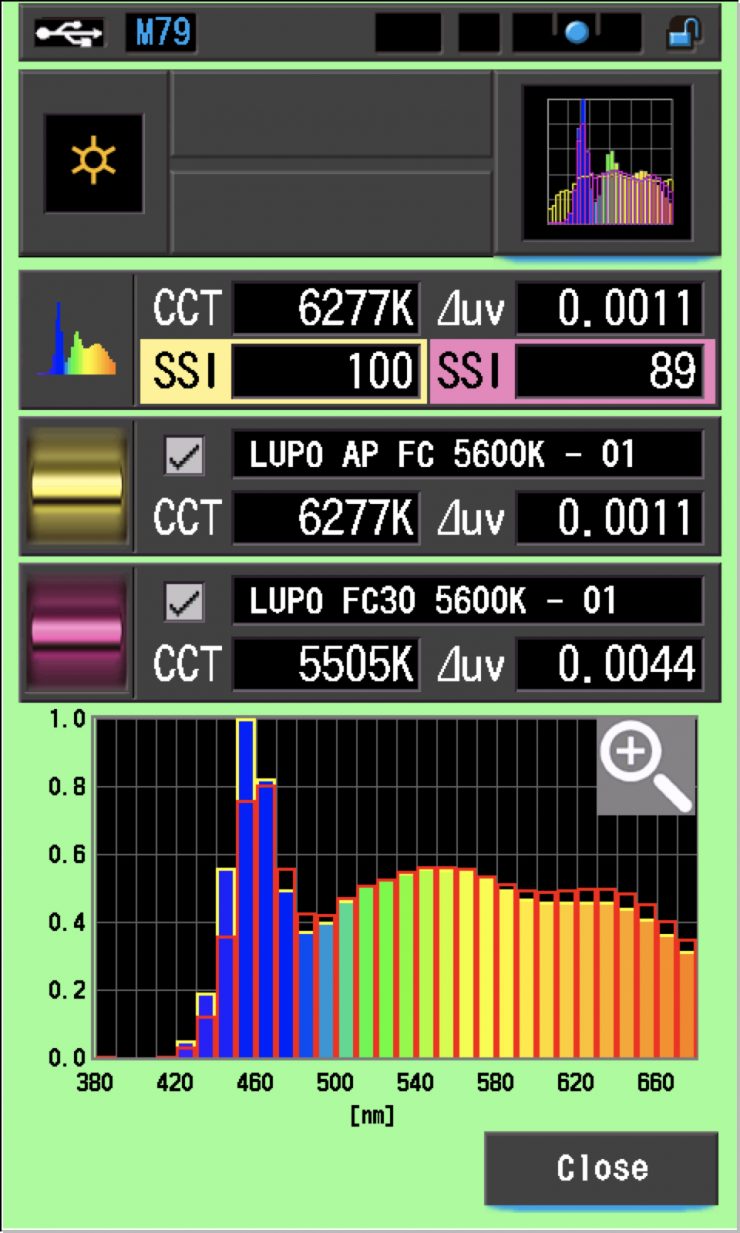
The main reason we want to record SSI scores is so we can see how well they match with other lights. I was curious to see how well Lupo’s Actionpanel Dual Color would match when used with the Actionpanel Full Color and Lupo’s larger Full Color 30 at 3200K and at 5600K.
At 5600K, the Acionpanel Dual Color and Full Color are a perfect match. The Full Color 30 isn’t an exact match, although with a score of 89 you could use it with these other lights without seeing much difference.
At 3200K the Acionpanel Dual Color and Full Color are a perfect match and the Full Color 30 is also almost an exact match. You could use all three of these lights at 3200K and they would all look the same.
Spectral Distribution
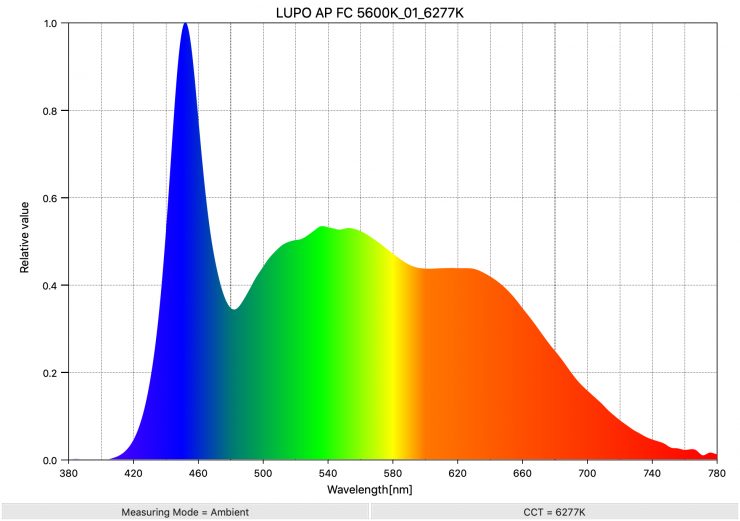
Above you can see the spectral distribution of the Dual Color when it is set at 5600K. The spectral distribution is fairly good at 5600K and the light only has a marginal green spike. This spectral distribution is fairly common for a lot of LED lights at 5600K.
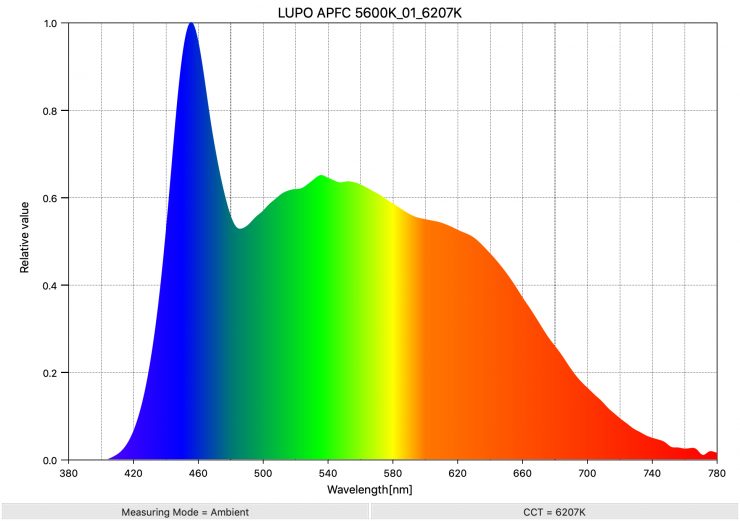
Above you can see the spectral distribution of the Full Color when it is set at 5600K. The spectral distribution is very good at 5600K. While the spectrum could be a little fuller, it doesn’t have any troughs or big spikes of any kind.
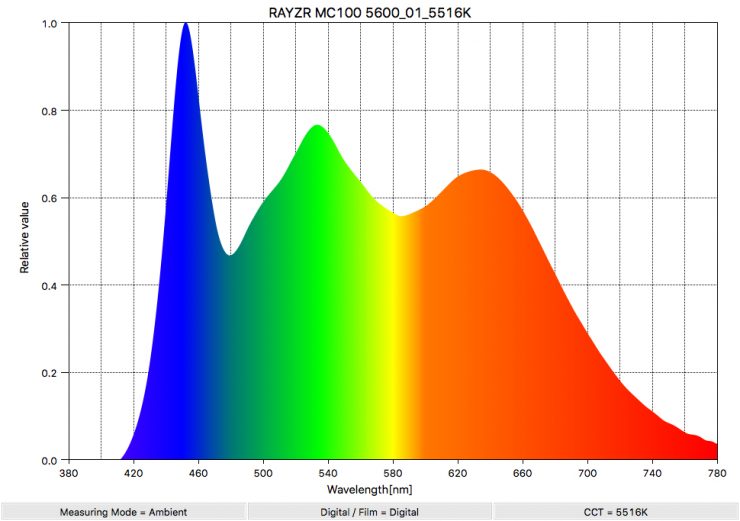
As a comparison, above you can see the spectral distribution of the Rayzr MC100 Multi Color RGBWW Soft LED Panel Light when it is set at 5600K. As you can see the Rayzr has a slightly fuller spectrum, but it does have orange and green spikes.
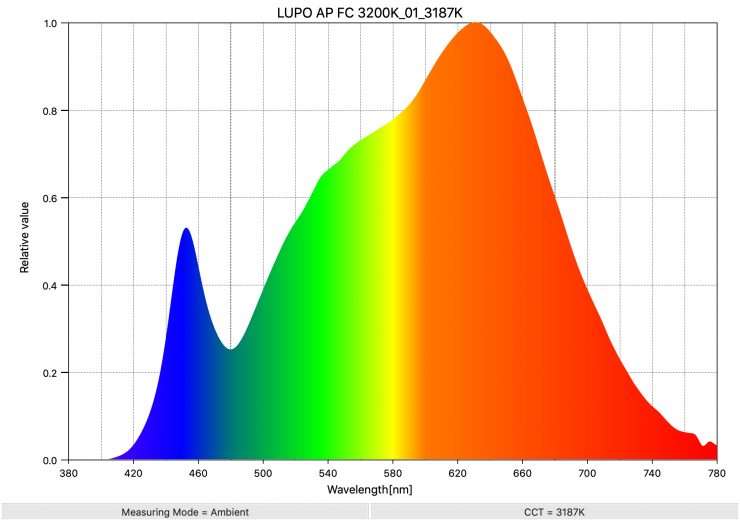
Above you can see the spectral distribution of the Dual Color when it is set at 3200K. The spectral distribution is excellent at 3200K and the light doesn’t have any spikes where it shouldn’t. This spectral distribution is very good for a LED light at 3200K.
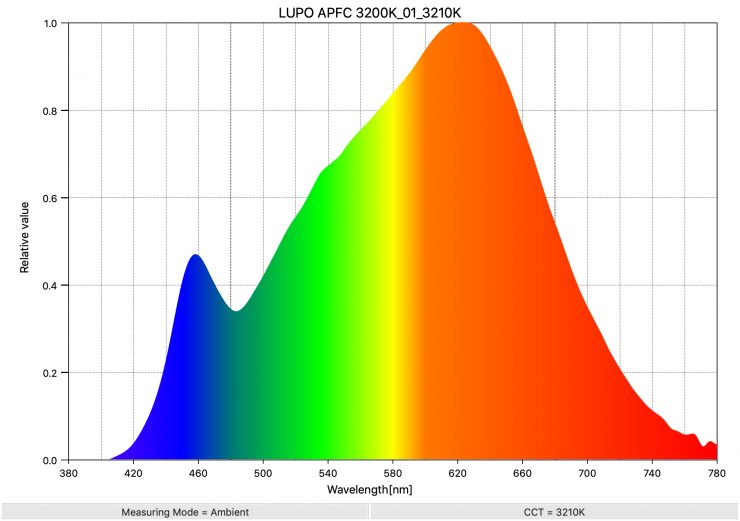
Above you can see the spectral distribution of the Full Color when it is set at 3200K. The spectral distribution is excellent at 3200K and the light doesn’t have any spikes where it shouldn’t. This spectral distribution is very good for a LED light at 3200K.
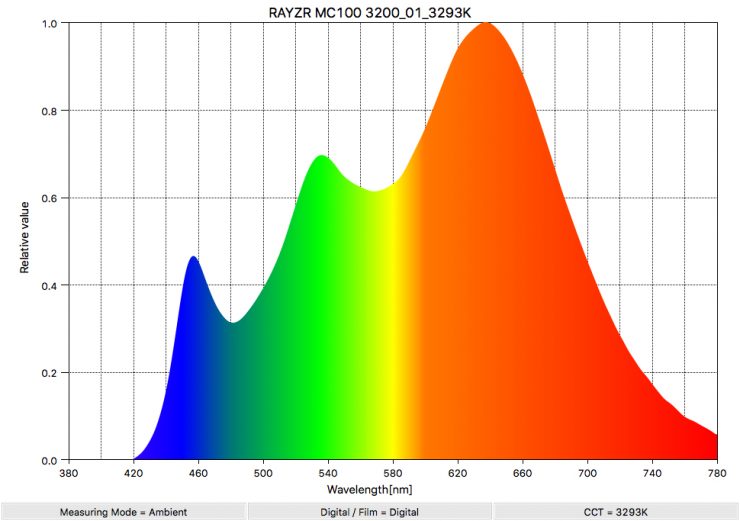
As a comparison, above you can see the spectral distribution of the Rayzr MC100 Multi Color RGBWW Soft LED Panel Light when it is set at 3200K. The Lupo has a much more even and linear spectrum than the Rayzr.
Real World Performance and Quality of Light
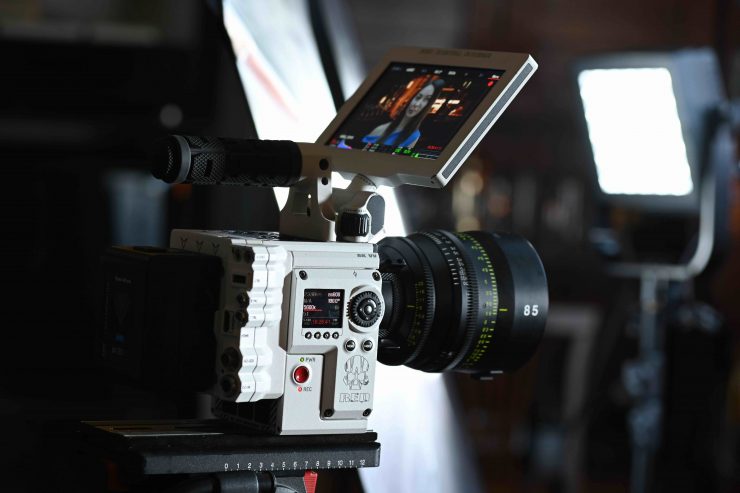
As I always say, photometric scores only tell you part of the story. So how do the scores from the Lupo Actionpanels translate into real-world performance?
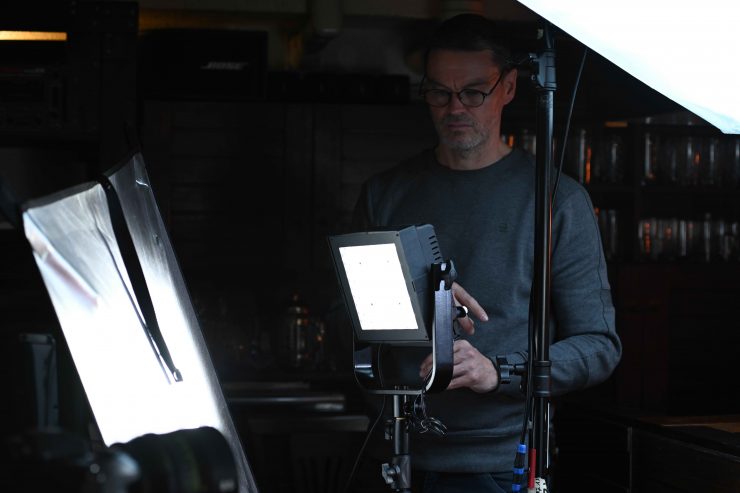
I used the lights for part of another upcoming review. In this scenario I was using two Actionpanels bounced into reflectors to create a softer indirect lighting source.
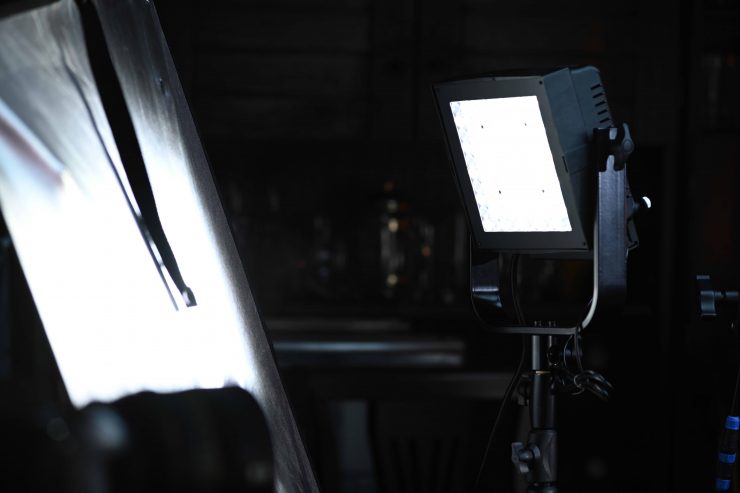
The Actionpanels work really well when used in this capacity. The high output and fairly narrow beam angle makes them a great option for times when you need to travel light but also want to create a fairly strong, soft lighting source.
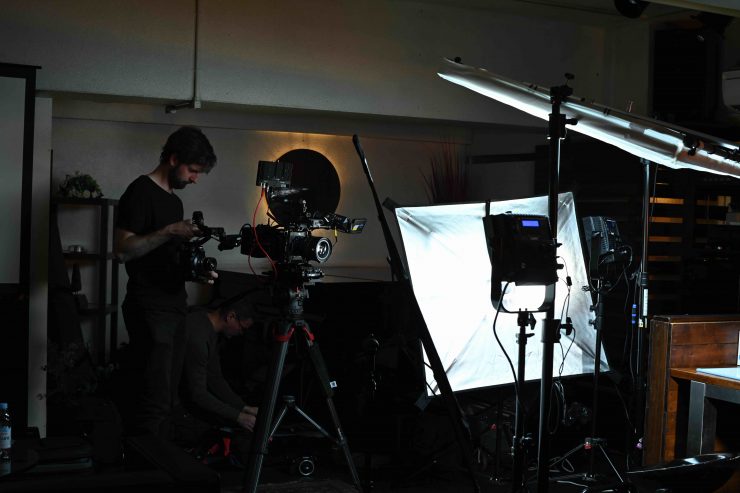
Starting with a bright source allows you to use the Actionpanels as both a hard or a soft light depending on what you require. In some ways, this makes the light more versatile than if it had a built-in diffusion panel. If you don’t have a high enough output to begin with, and then attempt to heavily diffuse that lighting source, often the brightness of that light is reduced to a point where it’s only usable when placed very close to a subject. I’m glad in this regard that Lupo didn’t choose to go with an in-built diffusion panel.
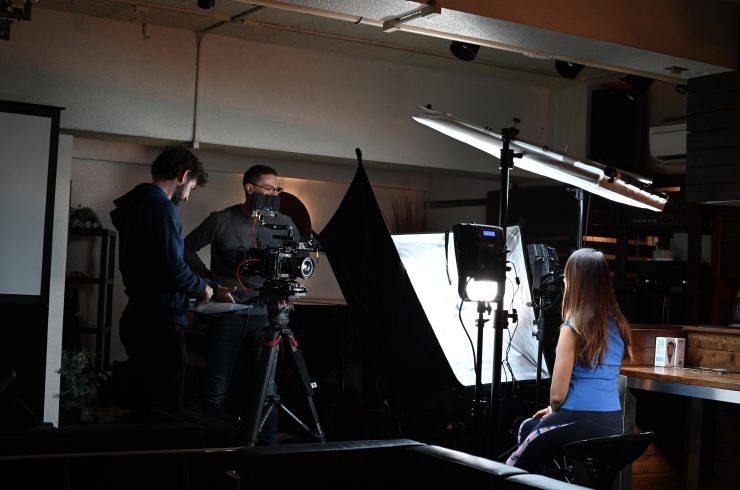
Conversely, not having a built-in diffusion panel does mean you do need to carry around more equipment if you plan on bouncing the light or using it through some kind of diffusion.
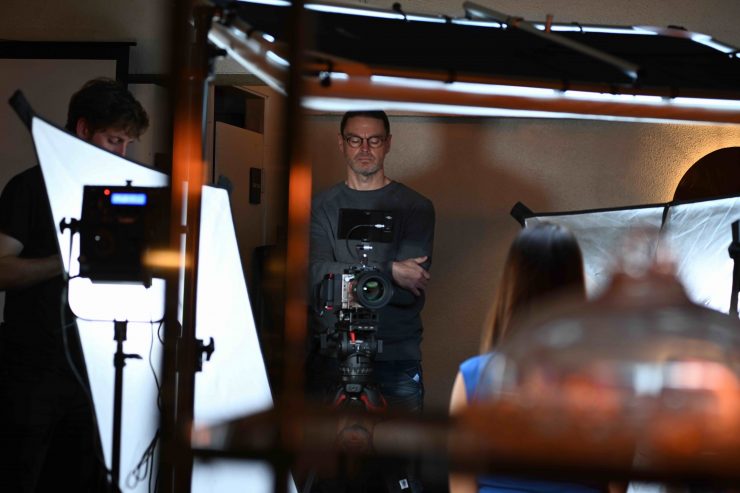
I was impressed with the Actionpanels ability to be used for a variety of purposes, given their small size, low power draw and high output.
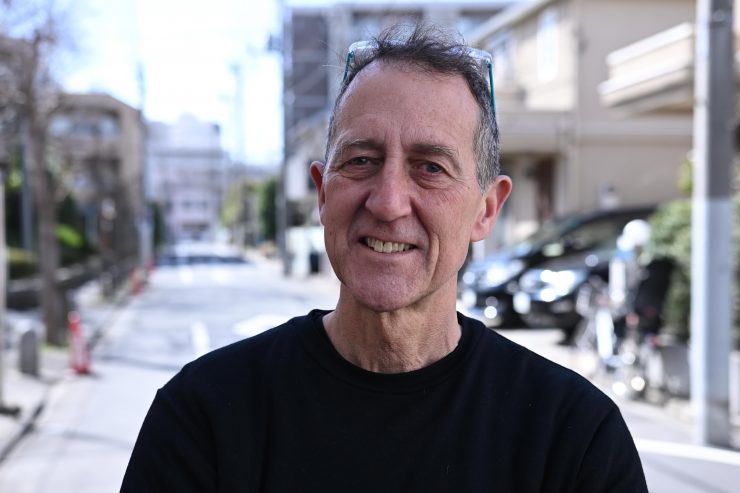

No light 
Using the Lupo Actionpanel 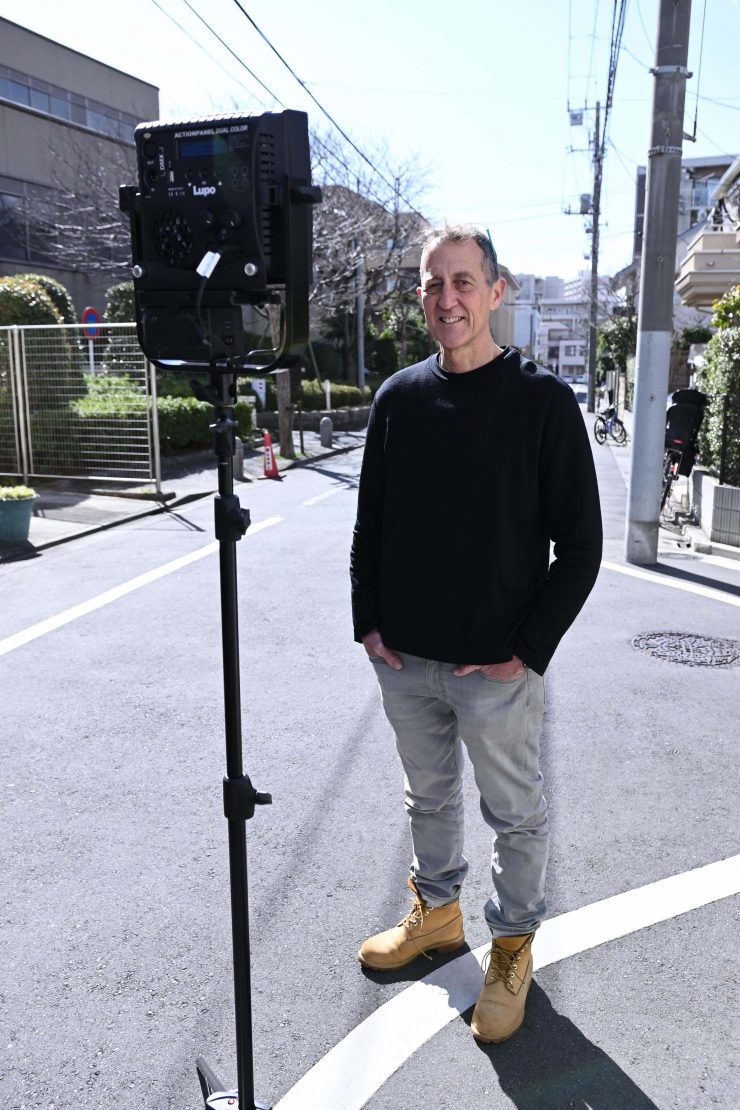
No light 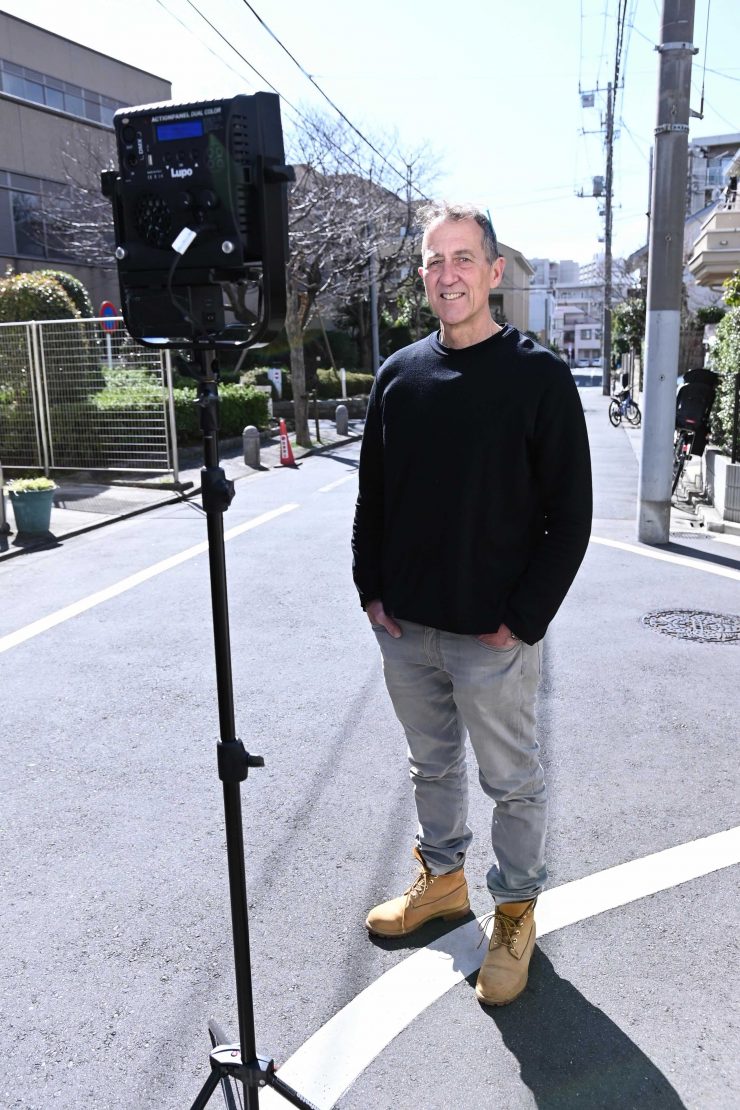
Using the Lupo Actionpanel
I also wanted to see if in a pinch you could use an Actionpanel as a small HMI outdoors and light up a subject for a PTC when you needed to match a background. Above you can see how that looks.
I was impressed that such a small-sized fixture with such a low power draw was able to work in a situation like this. Ideally, you would probably want to use two lights instead of one, but you can certainly get away with just using one.
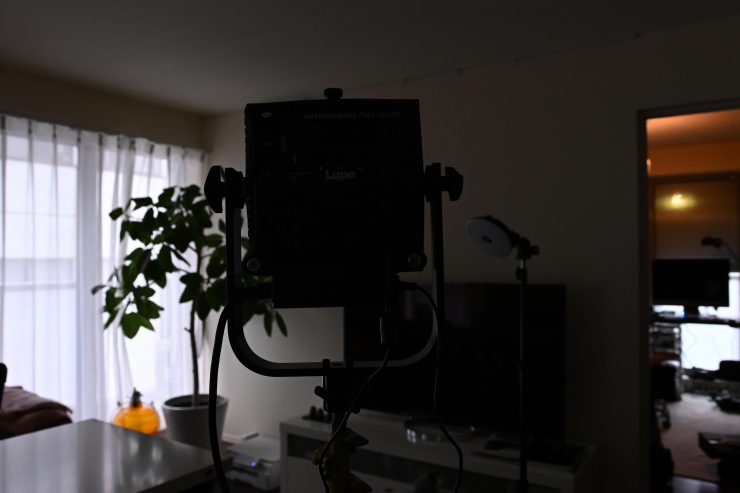

No light 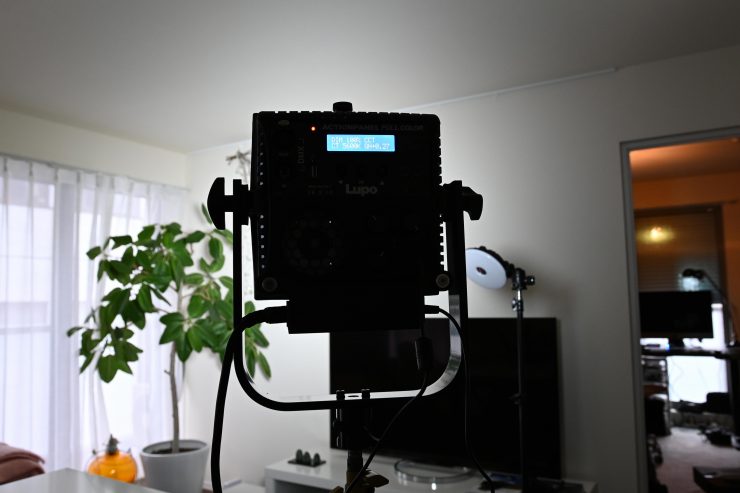
Full Color 100% 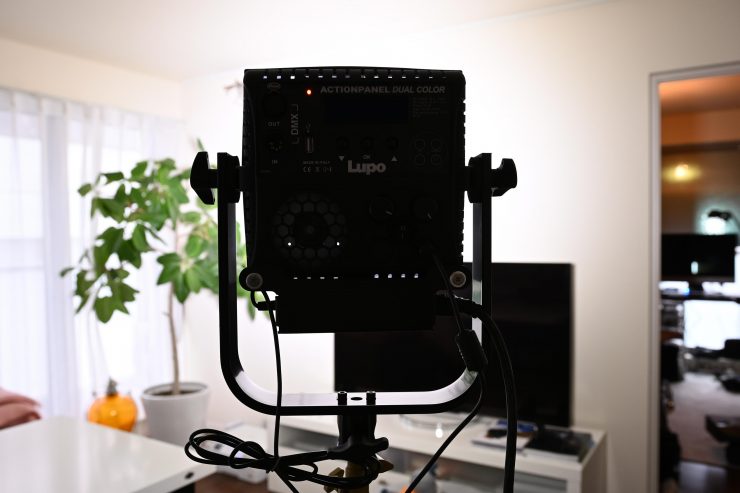
Dual Color 100%
Above you can also see a comparison of the difference in output between the Dual Color and Full Color versions. All three shots were taken at 800 ISO 1/50th shutter at F4.
Accessories
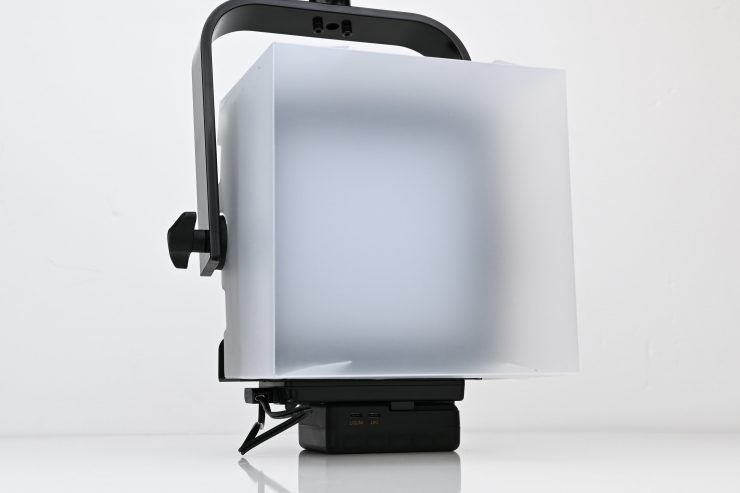
Lupo makes a large range of accessories for the Actionpanel series. The company has the following accessories available:
- Lupo Battery Plate for Actionpanel LED Panel (V-Mount) $79 USD
- Lupo Diffuser for Actionpanel LED Fixtures $29 USD
- Lupo Barndoors for Actionpanel LED Fixtures $98 USD
- D-Tap Cable $28 USD
- Backpack $169 USD
Price
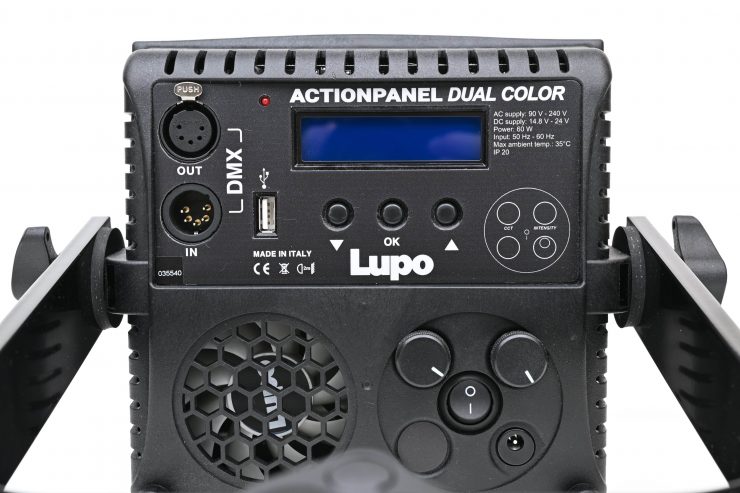
The Actionpanel Dual Color retails for $588 USD. The Actionpanel Full Color costs $788 USD.
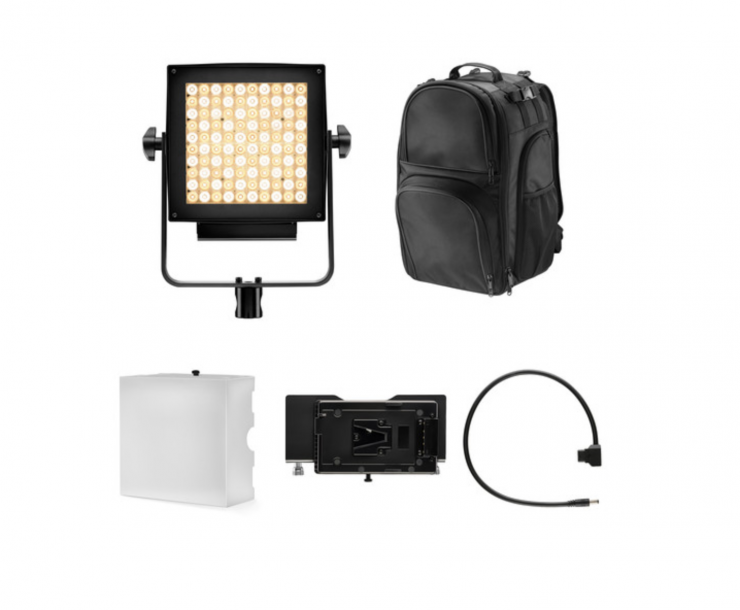
Lupo also has a Dual Color and a Full Color Actionpack available. They both include either a Dual Color Actionpanel or Full Color Actionpanel and the following:
- V-Mount battery plate
- Diffuser
- Backpack
The Dual Color Actionpack retails for $789 USD, and the Full Color Actionpack retails for $987 USD.
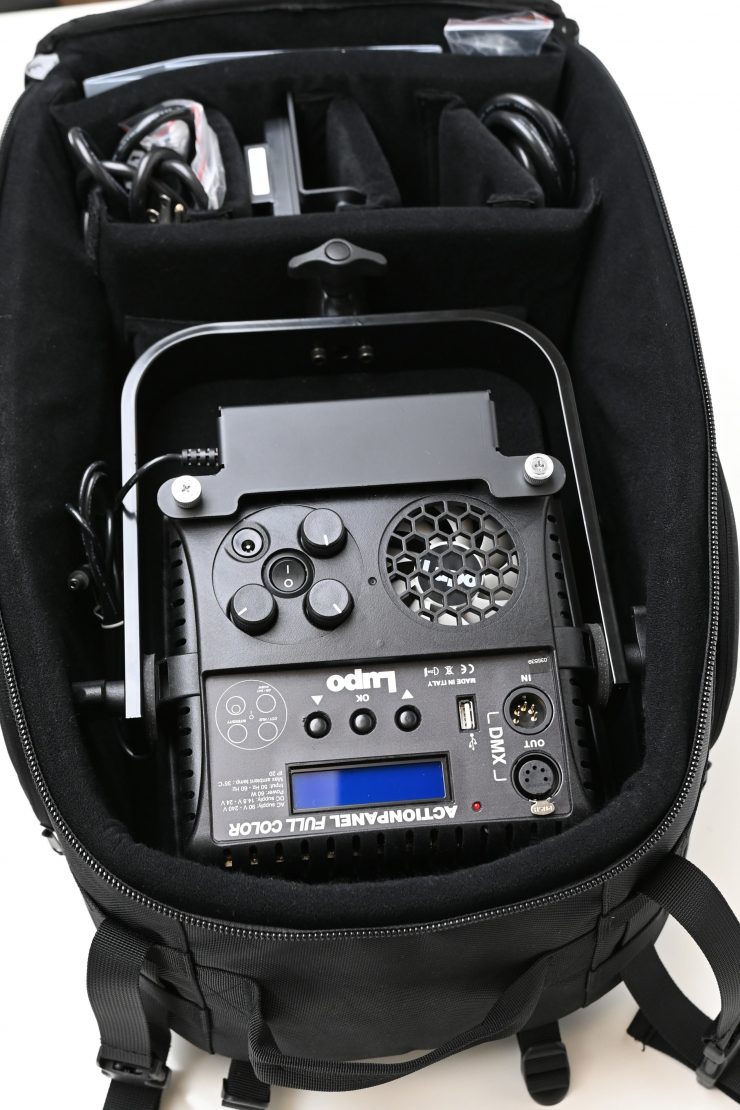
The backpack is well made and I found that you can fit two Actionpanels into the one bag. There are even some deep pockets on either side of the bag where you could put some compact light stands.
Competition
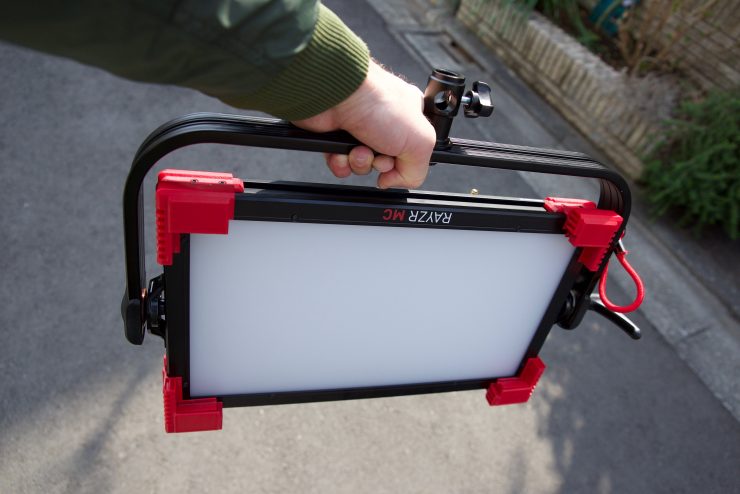

Rayzr MC 100 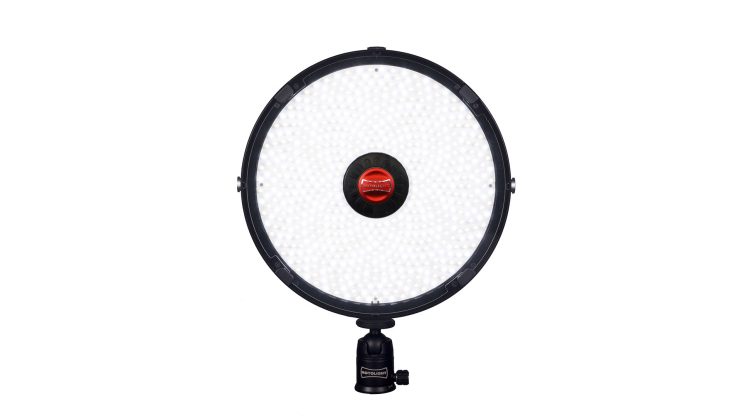
Rotolight AEOS
There aren’t a ton of lights around that I would consider direct competition to the Lupo Actionpanels. Two lights that I can think of that could be compared are the Rayzr MC100 Multi Color RGBWW Soft LED Panel Light and the Rotologht AEOS. Both of these fixtures, while different, are smaller than 1×1 sized panels and could be used in a similar way to the Actionpanels.
The Rayzr MC100 Multi Color RGBWW Soft LED Panel Ligh retails for $699 USD. The Rotologht AEOS retails for $994 USD. Both these lights come with built-in V-lock plates.
Conclusion
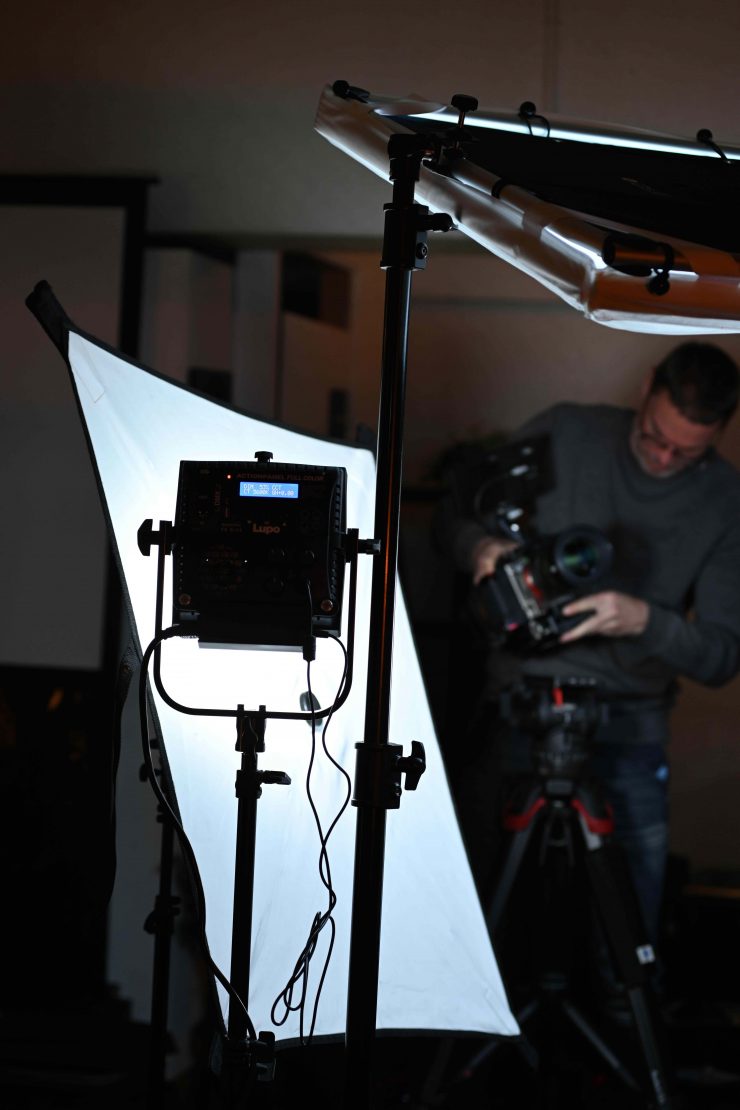
The Actionpanel Dual Color and Full Color lights strike a great combination of output, low power consumption, color accuracy, and portability.
You have heard that expression that you can’t have your cake and eat it too, well Lupo gives you the cake and lets you take a pretty big bite out of it.
It is a great alternative for anyone who has to travel with lights and use them in locations where mains power may not be an option. The 60W power draw, coupled with the high output makes these a great alternative to a conventional 1×1 panel. While they are perhaps not as versatile as a 1×1, when space and weight are at a premium they certainly make for a good replacement.
The Actionpanels are functional and efficient. They get about their job with minimal effort. They are quick to set up and easy to use. When you don’t have a lot of time for lighting then you need tools that help you get good results without eating into your shooting time.
Lupo continues to do an outstanding job with its product range, and the ActionPanels are another impressive offering from the Italian lighting company.
With a high output, good build quality, lower power draw, and a small footprint, this light is sure to find a home in many shooters’ kits.

